Text
The Kohbar of Lotus, Bamboo, and Clove - a new Kohbar for a new Generation
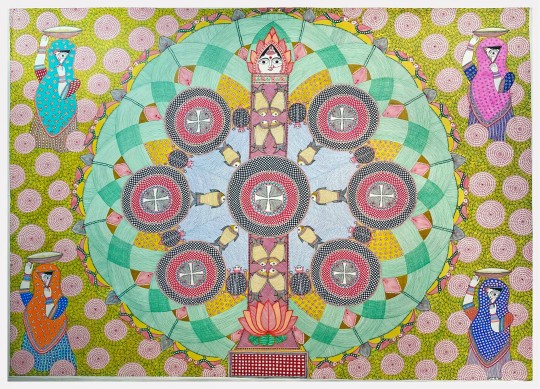
The kohbar image painted on the wall of a marriage room serves as a talisman to produce a fruitful union and protect the ceremony from the evil eye. The painting must follow a traditional iconography to be effective but in her Kohbar the artist Amrita Das only used some of its elements to produce a recognizable but abstract image of the kohbar. She said she was “only thinking of Lotus, Bamboo, and the sweet smell of Cloves”.
In the center, the Lotus plant with its many leaves represents female fertility - always the dominant image in the traditional kohbar as it is here. The light and dark intersecting green lines represent a stylized Bamboo grove, the male element. Typically the Bamboo grove is much smaller than the Lotus and often gets lost in all the traditional decorative elements of fish, birds and other auspicious images but with her Bamboo grove Amrita Das breaks completely with the accepted iconography and makes a deliberate and significant change. She depicts the Bamboo and the Lotus, the male and the female elements, as equals, the one embracing the other set in a field of red clove flowers which Amrita Das calls “ the spice of married life”. Cloves play an important role in Hindu ritual. They are offered to the gods in temples and protect babies and newly married couples from the evil eye. The four naina-jogins that are painted in the four corners of the marriage room are also present in the four corners of her Kohbar.

Amrita Das’ Kohbar began as an inchoate idea, not even conscious perhaps, when Tara Books invited the artist down to Chennai for a book making workshop some time ago. The result was the wonderful Hope is a Girl Selling Fruit, a book of paintings and prose, in which she muses on what it means to be a girl and considers her own future. The life of girls is hard from childhood on. There was always housework to do and no moment for oneself. No time to even dream. Would this ever end she thought. Would she ever have some time for herself? And even marriage, would that finally give her some freedom?
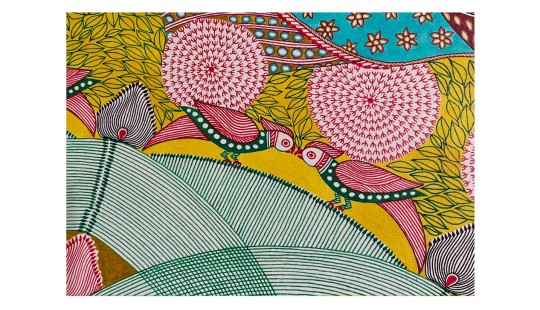
Six years after her marriage Amrita Das answers the question of marriage and freedom for women with her vision of a new kohbar in The Kohbar of Lotus, Bamboo, and Clove. She sees this new Kohbar not as a ritual formula for fertility but rather as a union here on earth of the cosmic male and female forces in the universe - the Bamboo and Lotus, two wreaths circling each other, are Shiva and Parvati as the god Ardhanarishvara, half male and half female in one body, together but separate.
The Lotus, Bamboo and Clove is the third kohbar painting that I’m aware of in the last couple of years which promotes Ardhanarishwara as the example of a marriage based on equality and respect for the female and the male. Such a marriage is one in which there is freedom. This is what Amrita Das’ revolutionary painting promises, a new traditional Kohbar for a new generation.

Amrita Das, The Kohbar of Lotus, Bamboo, and Clove, acrylic on a single sheet of Canson art paper, 4x3 feet, 2019. Signed and available.
.
2 notes
·
View notes
Text
The Kohbar Resplendent
The artist Shalini Karn has used the Covid lock-down time to present us with a wall-sized (7x7 foot) new interpretation of the Kohbar.

A magnificent Kohbar hovers large over the land its top reaching up into a dark blue sky with barely visible distant mountains.
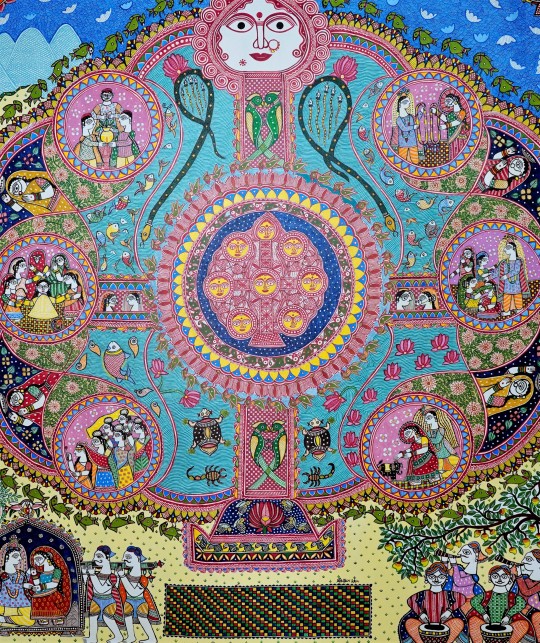
The Kohbar is elaborately decorated. Six symmetrical medallions, three on each side, circle the center while in their four interstices a naina jogin, in red or yellow sari with one eye uncovered, protects the wedding from evil misfortune. The light blue water teems with gaily colored and auspicious life, turtles, small fish, crabs, snakes and lotus flowers.

The Kohbar’s center is a second kohbar,a shining purain of yellow lotus leaves in an architecture of finely drawn red lines set in concentric circles of dark blue water, green parrots, yellow ornamentation, and the red pistils of the lotus plant. This second kohbar is a microcosm of the ‘maha’ (greater) Kohbar that surrounds it and together they are a paean to the power of the feminine.
This Kohbar is a force of love and joy and union.
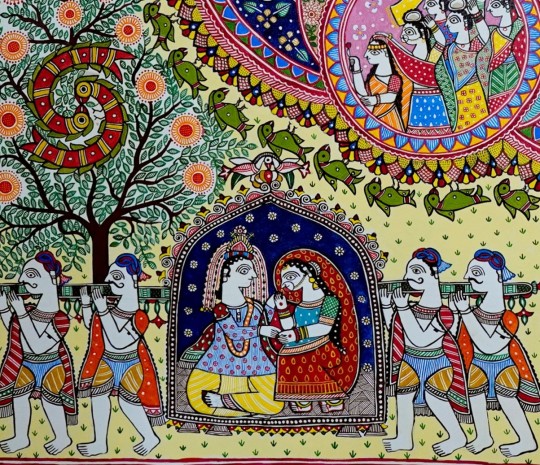
There is no longer the submissive bride alone in the palanquin being taken to an uncertain future but rather husband and wife together, facing each other, hand in hand, being carried to their new life. A pair of entwined love birds in a Kadamba tree sacred to Krishna is next to the palanquin. “And what is Krishna if not love?” asks Shalini Karn.
On the other side are musicians, drummers and horn players, making joyous
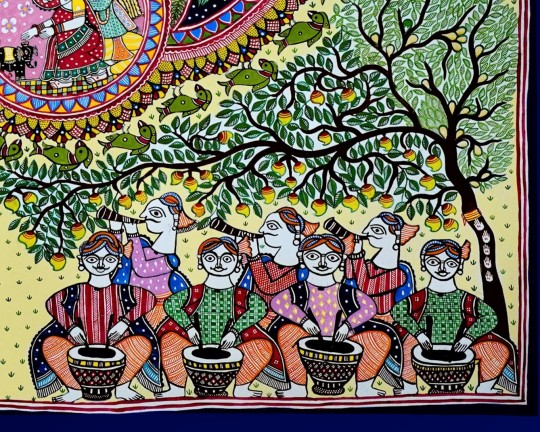
music under a mango and mahua tree where, before the actual wedding ceremony, the bride and groom held a ritual marriage with the trees for a happy and long marriage. Note the bride’s rice paste hand prints on the tree trunk and the yellow string tying the trees together.
You don’t see Shiva and Parvati here. Instead you have Ardhanarishvara,
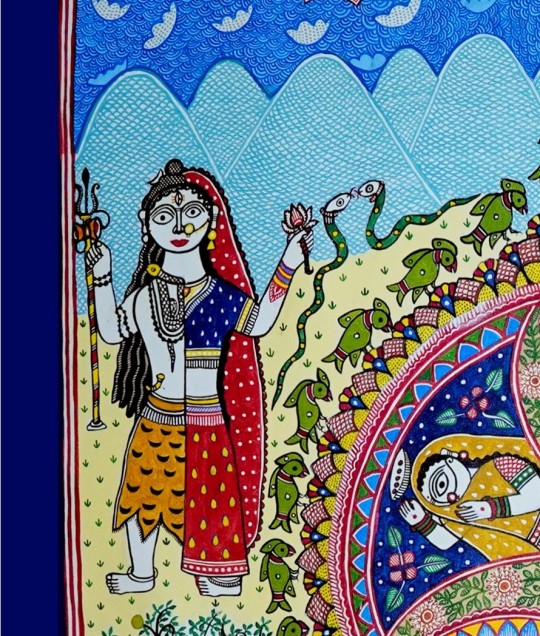
“the Lord who is also a female”, Shiva and Parvati , the union of male and female in one body. This union is now also that of the bride and groom. They have become one.
Shalini Karn is not the first to use Ardhanarishvara as an attempt to give a religious basis for the equality of male and female in the strongly patriarchal society of Bihar. The artist Shalinee Kumari has long struggled with the same question and has also painted a kohbar with Ardhanarishvara. But Shalini Karn by taking the kohbar outside the confines of the marriage room and into the open air has lightened the weight of tradition. She uses the figure of Ardhanarishvara to support the equality of male and female and thus her emphasis is on the love and joy of marriage and the open future of possibilities promised by her Kohbar, glorious over the land and the infinite blue sky.
Shalini Karn, The Kohbar Resplendent, acrylic on canvas, 7x7feet, 2020. The work is signed and is available.
5 notes
·
View notes
Text
"Amrita Ka Balidaan"
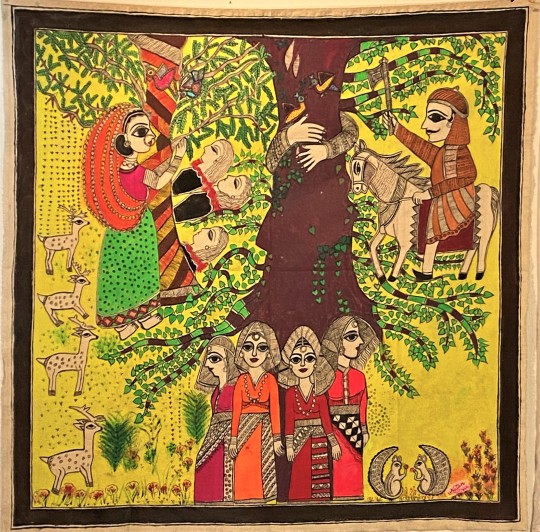
The tree floats in the air, branches above and roots below, two arms from behind the thick trunk embrace it. The composition fills the entire space; the dark umbar colored tree dominates the center, on the right a rider in bronze military armor, ax raised high, and on the left Amrita in village garb, barefoot, embracing a tree, her daughters' severed heads at her feet. Directly below the tree four women, like Egyptian goddesses, stand erect shoulder to shoulder facing the viewer.
Nutan Mishra a self-taught painter from Sitamarhi, Bihar painted Amrita Ka Balidaan (Amrita’s Sacrifice) as dual homage to a historical three-hundred-year-old event as well as to Chipko, an ecological movement with a large participation by women that began in the 1970s to protect the lower Himalayan mountains of north India from deforestation. A hugged tree is taken as a symbol of the movement.
Amrita’s Sacrifice took place in the 1730s when a Maharajah in Rajasthan sent soldiers to cut down trees for a new palace. The villages in the area however were part of the Bishnoi community which considers nature sacred and to be protected. To stop the soldiers from cutting a tree Amrita Devi offered them her head instead, “Saving a tree was worth the loss of one’s head.” Her three daughters followed suit. Seeing their sacrifice other villagers stepped forward. Over 360 in all, young and old, were thus beheaded before the soldiers stopped and rode away leaving the trees uncut.
Painted in neon acrylic on Salita, a rough cotton cloth, the 39″ x 39″ painting is a bit of color shock at first but the strong triangular composition, as well as the carefully chosen individual colors, hold the work together. The yellow background serves as canvas for the dark trunk of the tree, the green of the branches, the bronze of the rider’s armor, the dark green of Amrita’s skirt and the orange of her head covering. The four elegantly dressed women are all in red tones - magenta, orange,red, and rose. They reference a black and white photograph from 1973 of village women protecting a tree in an attempt to stop logging in their area.

But instead of presenting them as village women Nutan Mishra chose to portray them as goddess guardians of the forest - thus connecting them with the Bishnoi community’s sacrifice centuries earlier.
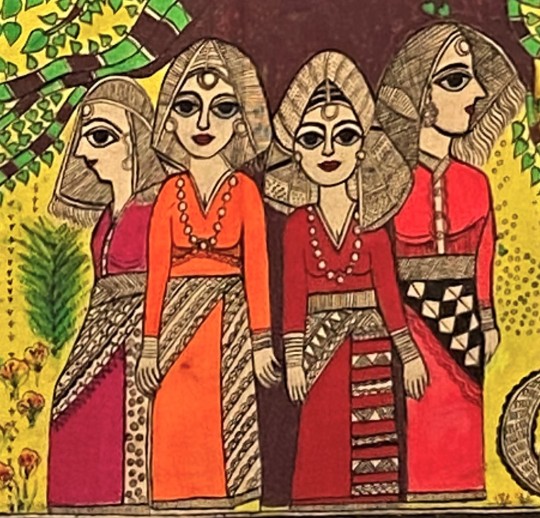
Signed by Nutan Mishra, neon acrylic on Salita (rough cotton cloth), 39in x 39in, 2019.
Acquired in December 2020 by Radford University Art Museum, for display at Radford University's Selu Conservancy
Photograph India Times.
6 notes
·
View notes
Text
Women Fish Vendors
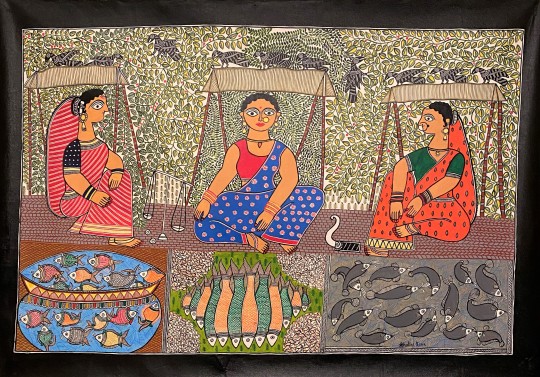
Shalini Karn painted Women Fish Vendors for the by-invitation-only International Folk Art Market (IFAM) in Santa Fe, New Mexico in 2019. Her visa to attend the event was denied so I thought I would bring the work to you here.
The painting is striking in its symmetrical tripartite composition. Against a background of curving branches of green and yellow leaves dotted with red berries three women fish vendors occupy the entire top half of the canvas. They share the space equally, each one under a similar canopy on bamboo poles. The bottom half of the canvas is divided by their displays of fish, each display directly in front of each of the women. Three spaces set over three spaces - six frames in all for the art. Meanwhile, elegant black crows with white stripes march across the tops of the canopies adding a touch of whimsy to an otherwise formal design.

The women in their simple saris appear as confident figures sitting purposefully, proudly with their attractive arrangement of fish for sale. The central figure immediately catches our attention. While her two companions on either side are shown in profile, relaxed, waiting to sell their fish, she boldly confronts passersby with her direct gaze to have them stop and take a look at her fish. Waiting is not her game. The displays themselves are a delight of artistry and imagination. The large glass vat is swimming with small fish their scales flashing bright colors in the blue water while the middle display of large yellow and aqua colored fish sits on a bed of green leaves artfully surrounded by heaps of small fry fish. A shallow tank filled with the supple curves of swimming grey carp is the third display. Their dark bodies, white heads and curling mustaches clearly visible against the lighter grey of the tank.
The artist presents a wonderful tableau of women fish vendors and also shows that selling fish at a market is no simple matter but requires confidence, courage and a bit of art in attracting customers.
Signed by Shalini Karn the work is acrylic on canvas. Overall dimensions are 60x54 in. but picture size is 42x35 in. 2019.
3 notes
·
View notes
Text
Bhamati
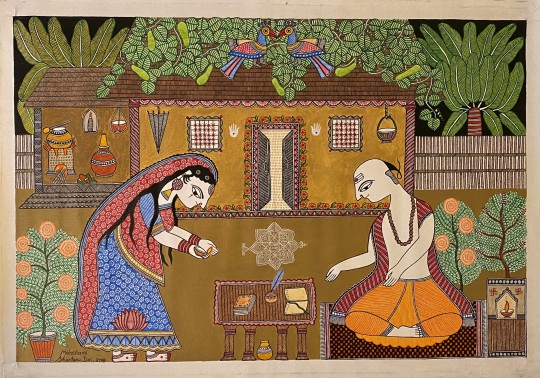
Well drawn and beautifully executed this painting by Mahalaxmi has both a scholarly appeal as well as an aesthetic one.
It represents Bhamati the long-suffering wife of the great scholar Vachaspati whom she served for years while he wrote his famed commentary on the Advaita Vedanta the non-dualistic school of philosophy based on the Upanishads. When he finally finished the work it is said he looked up and seeing her asked who she was. I'm your wife she replied and thus he called the commentary Bhamati.
Mahalaxmi tells the story with insight. Bhamati bending forward with barely suppressed tears offers a lit oil lamp for Vachaspati's evening study while he bent over his commentary doesn't even look up to acknowledge her. The beautiful house with a well ordered open kitchen and clean yard also tells of Bhamati's effort to make a setting where his work is paramount. Everything organized to shut out the world, from the house bordered by fences and palm trees to the empty clean swept yard.There are love birds over the doorway but no sign of domesticity. Nothing of theirs, no parents, no children. The umbrella hanging near the kitchen area the only hint of a world outside they cannot control.
The work signed by Mahalaxmi and Shantanu Das is acrylic on canvas. Overall dimensions are 41x28 in but picture size is 35.5x23.5 in. 2018.
>
1 note
·
View note
Text
The Vernacular on the ground in Madhubani
I needed to come back to the blog on the occasion of the International Delhi Art Fair in New Delhi that took place Feb 2 - Feb 5, 2017. Unfortunately I was unable to attend the event and so missed the exhibition of Vernacular art curated by art historian Annapurna Garimella which included Gond, Mithila and Mysore artists. Though space was limited, the exhibition offered much needed exposure for India’s indigenous art forms.
Here I would like to present six artists whose work I think truly shows what is happening on the ground in Mithila art: the excitement of experimentation and the search for a personal artistic path in the face of social and technological changes.
Avinash Karn ‘Munna, Smile Please’, 36″x24″, acrylic on canvas, 2016.
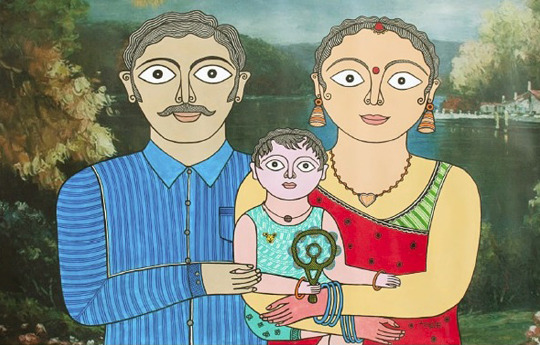
Avinash Karn studied art at Banaras Hindu University and then spent the last couple of years sowing the seeds of Mihtila art in India: painting Mithila-style hotel murals in Gurgoan, teaching the basics of the art to tribals in Jharkhand, holding Mithila workshops in Goa. In this piece he photo-shopped a traditional photographer’s studio backdrop onto canvas and then painted the portraits in the areas left blank. Combining traditional photography practice with current day digital manipulation and finishing with a painted portrait in the Mithila style not only gives an engaging picture of a middle-class family in today’s India but also presents the options, choices and tools Mithila artists have at their disposal today.
Mahalaxmi and Shantanu Das, ‘Kohbar Monologues No 2′ , 22″x30″, acrylic on paper, 2016.
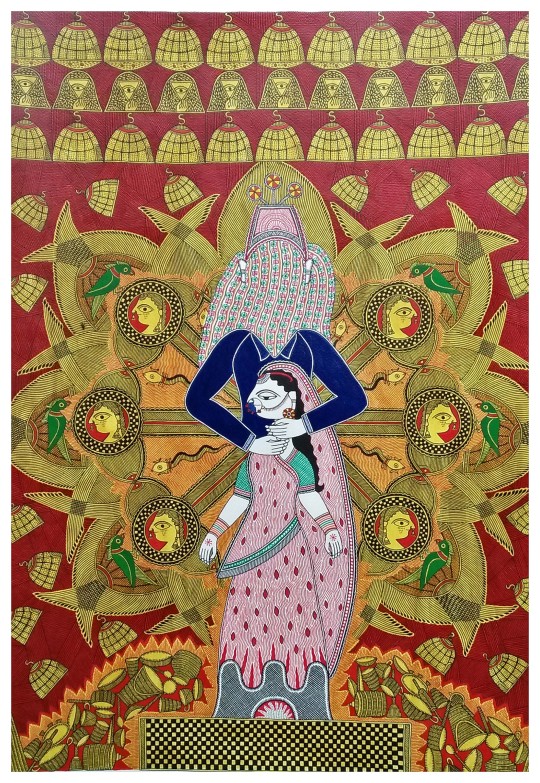
A chilling piece of theater. The husband in traditional bridegroom headdress chokes his wife as flames reach up her sari from the household cooking fire. The rich, thick, blood red color adds a quiet horror to the scene while the lotus pond wedding kohbar is deconstructed here as a wheel of torture, the lotus flowers the tearful faces of brides. Bamboo representing the male lineage becomes scythes that surround and further entrap the unfortunate young wife. On high, old women peer through their saris at a scene they are helpless to prevent.
The traditional kohbar symbols painted on the walls of the wedding chamber represent the hope of a fruitful and happy marriage. Here they become instruments of oppression and death. A powerful painting dealing with a reality that manifests itself in various guises in contemporary Indian society. Though this artist team had a large canvas work in the exhibition in Delhi, this painting is extraordinary and a must in any exhibition of contemporary Mithila art.
Shalinee Kumari . At age 23, via the Mithia Art Institute in Madhubani, Shalinee Kumari made the journey from the small village of Baxi Tola near the Nepal border to San Francisco for her one woman show. After a two week stay in the States she returned to India, married, and now lives in Hyderabad with her husband and daughter where she teaches and continues to paint.
Betiyaan Parayi Hoti Hai (Daughters Are for Others), 30″x22″, acrylic on paper, 2016.
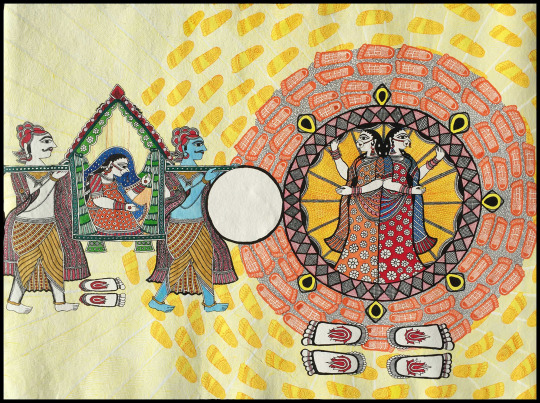
The bride carried to the husband’s home loses not only her birth family but also has no rights in her husband’s family. This is the patriarchal tradition. Shalinee Kumari is not the first to ask why this must be so, as songs on You Tube attest, but she is the first Mithila artist to so elegantly limn this tradition. The footprints go in circles, in both directions. They point back to the old family and forward to the new. They search for an answer. And as in the songs there is no answer. At least not yet.

Amrita Jha is an accomplished artist and a Mithila Art Institute graduate. Though currently at work on a series of bird paintings much of her art is informed by the problems of being a woman in a highly patriarchal society. Here her The Curses Begin, 40″x33″, acrylic on paper, 2016.
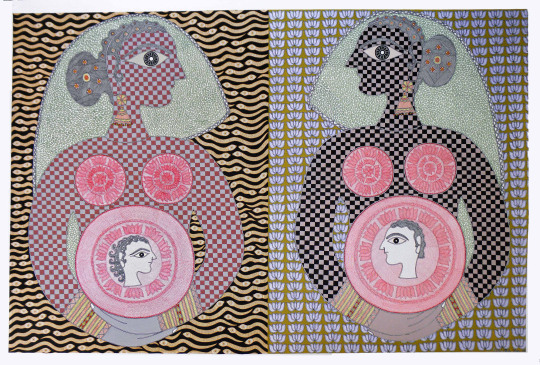
“Usually, a mother-in-law starts to curse the day she knows that her
daughter-in-law is carrying a girl child in her womb and becomes
extremely happy if she is carrying a male child.” Amrita Jha
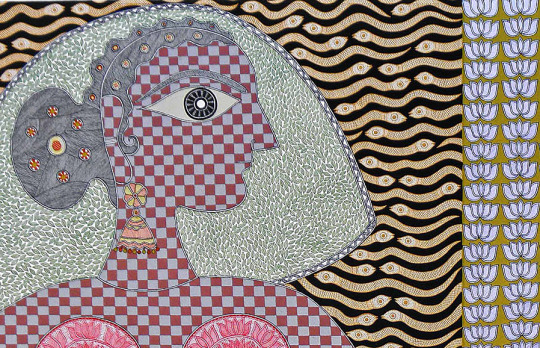
Unmatched in her attention to line,color and detail, Amrita Jha here gives us a stylized, formal portrait of two beautiful young women, facing each other, nearly identical mirror images except for the background behind each: one a wall of light purple lotus flowers while the other a field of undulating golden snakes. The gems in their perfectly coiffed hair, their golden earrings, the multiple colored bracelets on both wrists and their shimmering saris give them a somewhat haughty air which is softened by their clasped hands tenderly supporting their yet to be born son and daughter. Both mothers, both awaiting the birth of their child.
But note how, reflecting popular sentiment, the artist’s choice of the vertical gives the boy child’s mother a height and authority denied to the mother holding the daughter. The vertical rows of lotus flowers continue up to the heavens while the horizontal lines of snakes create a visual field that surrounds and entraps this mother and her future daughter. The sex of the child also reflects back onto the mother where the darker, contrasting colors of the figure cradling the boy give that figure, a presence, a self assurance that is lacking in the mother-daughter figure with its slightly anemic colors.
The Curses Begin is a well conceived and well crafted piece exhibiting the best of traditional Mithila Kachni Bharni (line and color) painting .
Naresh Kumar Paswan: To complete my selection of current Mithila Vernacular painters I must also include Naresh Kumar Paswan. He is a unique, self-taught talent whose work resembles no other. All in black pen and ink with geometric lines that make his work seem a handcrafted woodcut, he paints scenes from Indian stories as well as nature. If Surya the sun God appears a bit fierce in this piece, that is deliberate. Naresh says that in the middle of the Indian summer, out in the villages, the sun is anything but your friend.
Sun and Pond 22″x30″, acrylic on paper, 2014.
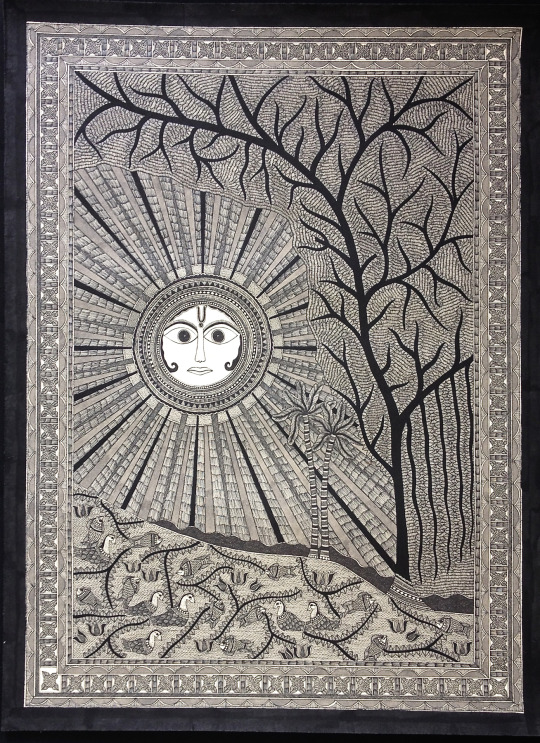
I suggest that these are some of the most interesting artists working in Mithila art today. Some already accomplished but still relatively unknown, while others are just ‘emerging’ as the galleries say. For now the Vernacular in Mithila/Madhubani art lies with them.
4 notes
·
View notes
Text
Mahalaxmi and Shantanu Das
A New Collaborative Talent in Mithila Art
It’s been a long time since my last post but I just had to come back and introduce you to two Mithila artists, Mahalaxmi Karn and Shantanu Das, who are producing some of the most interesting and innovative Mithila art today. Whie Mahalaxmi has described their collaboration as somewhat complicated, generally the two work together on concept and design while she then does the line work and Shantanu concentrates on color. They consider themselves contemporary Mithila artists meaning that they work within the general parameters of the classical style but reserve the right to expand or contract the Mithila vocabulary whenever that’s necessary to achieve the painting they envision. Take a look at what I consider to be their signature contemporary piece: Fisherman and Boy.

Fisherman and Boy 20″ x 26″ Acrylic on paper 2012
It’s an immediately striking painting with that billowing net reminiscent of an antique phonograph catching our attention. The two fishermen in the center and the group of fish below complete the painting.
The composition is tightly designed with exactly these three elements. All are on the central axis of the painting, all are approximately the same size, and all equidistant from the edges of the painting. The fisherman stands tall in the boat, feet spread, hands holding the rope as he casts the circular net which opens wide in the sky over the huddled fish at the bottom of the water. The action is frozen. The water, a Mithila style patchwork of nearly invisible, finely drawn lines, presents a uniform background that lifts the figures off the paper into their own space and time giving them an almost iconic status. The artists have chosen the moment when the net is tossed. They have pared that moment down to three elements and presented the whole in a minimalist fashion producing an extraordinarily captivating image of what it means to be a fisherman.
The work is a superb balance of color and line and shows how well the artists complement each other. The darker colors of the net and the grouped yellow fish set against the black depths of the water, the reddish brown checkerboard pattern of the boat and the vibrant red dhotis of the fisherman, they all vie for our attention and all are a visual pleasure. Though the colors attract us first, the line work is marvelous and contributes as much to the success of the painting as does the color choice.
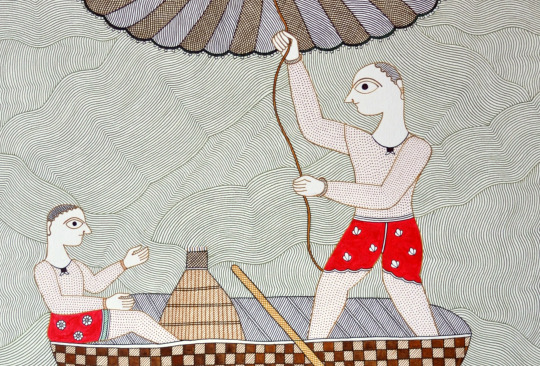
Fisherman and Boy (detail)
Note the flow and movement of the background water between the bottom of the net and the head of the boy sitting in the boat. Here you clearly see the crest and the trough of the waves, while elsewhere the water appears as a smoothly rolling wave or as a current temporarily stopped in its flow by the movement of other waves. There are many examples where touches of Mahalaxmi’s pen enrich the overall effect of this piece. The tiny threads that come off the edges of the open net add a nearly imperceptible decorative element to that already attractive design, or the light reddish stippling on the fishermen, barely noticeable, yet the color complements their dhotis and softens their forms against the pale green background.
Finally, there are the contradictory viewpoints. The water is presented in a top down view while the figures are seen from the side. This simultaneity of viewpoints sets the figures into the foreground. In fact, all the decisions made in the painting - the very fine lines for the water, the color choices, the different viewpoints - they all come together to make the fishermen and their boat appear to float over the water, to be separate from this transitory world, producing a timeless Mithila hieroglyph of fishermen at work.
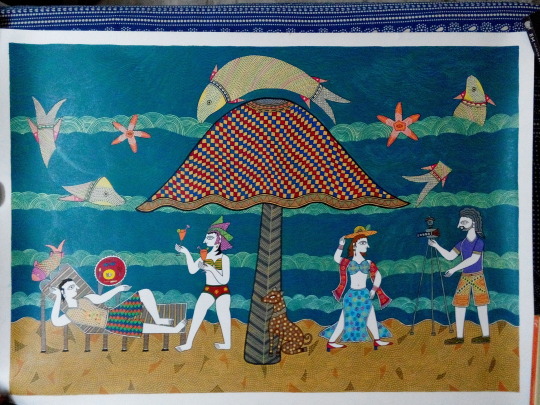
Sea Beach 27.5″ x 40″ Acrylic on paper 2014
If the previous piece is a tour-de-force of line and color, the very contemporary Sea Beach is all about color with a bit of fun and tongue-in-cheek social commentary.
The wonderfully checkered red, yellow and blue beach umbrella-palm tree divides the painting vertically in two with one side nearly a mirror image of the other. The intense aqua marine sea with its leaping dolphins and brightly colored star fish acts as a carnival backdrop to the activity on the sand. Here two sets of couples play out typical roles that might be seen on any summer beach. In one, a young man reclines indolently on a chaise lounge, one hand casually behind his head, while a bikini clad young woman hurries toward him carrying a drink in each hand. In the other, a woman poses for her male friend who has set up his camera on a tripod. The women are mirror images of each other differing only in their dress. And though they appear to be carrying out their expected roles, their strong, forceful strides suggest that they are actually more than passive participants in these scenes.
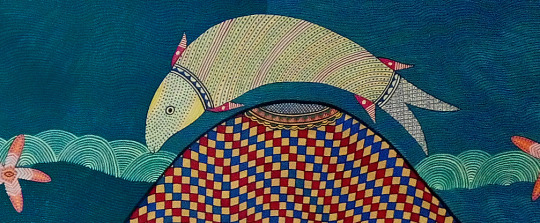
Sea Beach (detail)
Color predominates in this painting but line is there to enhance the effect as is clear in the above evocative detail of that summer day. There is the coolness of the rolling surf and the promise of shade by the harlequin-painted umbrella, but the joy of that summer day is epitomized by the leaping dolphin with its multi-colored shining body. The skillful stippling and hatching join with color to a wondrous effect.
While Mahalaxmi and Shantanu produce highly successful contemporary Mithila paintings, they are equally adept at painting in the classic Mithila style. See below the sketch of a Maithil Brahmin - a preparatory piece for a larger color work on canvas.
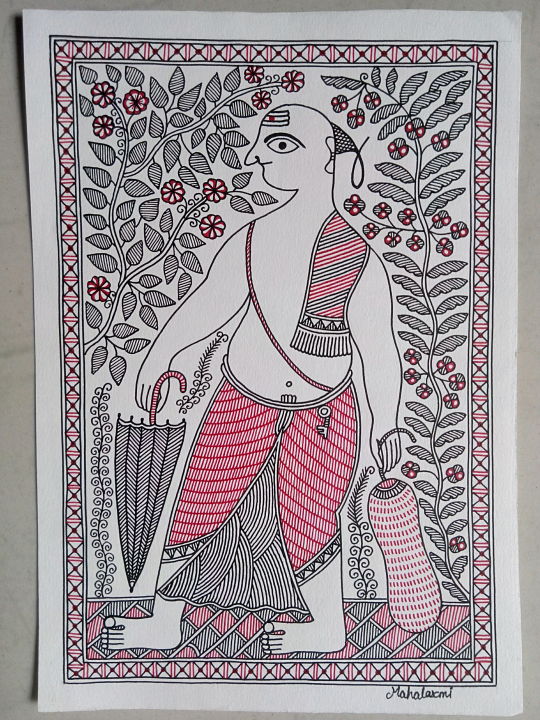
Maithil Brahmin 7″x 10″ Acrylic on paper 2013.
Here are all the classic elements: a border, figure in profile with the large almond shaped eye, and a background filled with decorative branches and flowers. And yet there is something new here. This is not simply a drawing of a male figure we should understand to be a Brahmin. Look at the round chin, the mouth and nose, the soft curve of the arms and middle. I am looking at a well-fed and very self satisfied Brahmin, one that represents a type or might even be a specific figure seen on the street. The figure of this Brahmin has a personality.
Here is Mahalaxmi on the painting: “My version of a Maithil Brahmin carrying a bottle gourd and umbrella...our place is still full of such males paunchy, topless in the summers; carrying even the odd key to their metal trunks hanging from their waist.....I was contemplating upon portraiture in Mithila style...due to some reasons, have not been able to carry on. But in the future would definitely add more to it on a bigger scale”
I have always wondered whether Mithila art could do portraiture and I think this piece shows that perhaps it can. I hope with all their many interests, projects, and dreamed-of-paintings that these two artists will find time to explore portraiture within the Mithila style. They certainly have the talent, energy and at this particular time in their artistic career the courage and passion to explore a new territory in Mithila art.
I end this post with one more superb painting in the classic style. I think this piece sets a high mark for anyone contemplating the same scene from the Ramayana epic: Hanuman flying back from the Himalayas carrying the Dronagiri mountain that has the Sanjivani herb to revive the dying Lakshman.
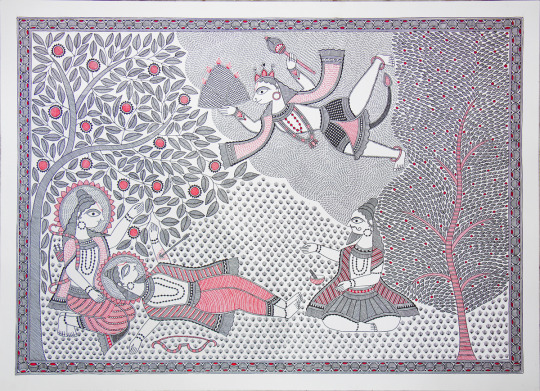
Hanuman 30″x 40″ Acrylic on paper 2015.
This is all line, a wonder of hatching, stippling, and repetition of elements. Color is kept to a minimum, just enough to identify the actors in the drama lest we get happily lost in a lyrical abstraction of lines. The landscape has four clearly delineated areas. There is the triangle at the center with its repetitive iconic blades of grass laid out as a carpet for the dying Lakshman and grieving Rama. A tree on each side rises to the top of the painting. One with graceful boughs bends under the weight of large red fruit while the other stands tall with dense, small leaves repeated in such patterns that the whole tree appears to quiver with life, responding to every slight breeze. Hanuman himself, magnificent in contrasted red and black dress, appears high in the sky. Balancing the Dronagiri mountain with its life giving herbs on his right hand while his left holds his iron tipped mace, he arrives in time to revive Lakshman and save the war against the demon king Ravana.
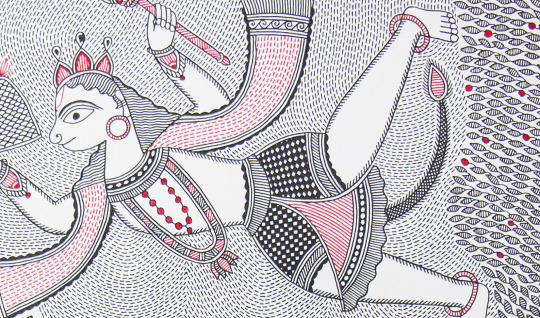
Hanuman (detail)
Line work predominates in Hanuman with an almost intoxicating effect: the dashes creating the never completed circles of swirling air, the tree leaves moving in all directions, the lines of the shawl flowing gracefully, their red color contrasting with the black swirls of the air. Your eye follows one pattern that leads to another pattern then jumps to a third - all visually interesting, all immensely enjoyable. A superb piece of drawing by Mahalaxmi that continually keeps one looking for more.
I met both of the artists a number of years ago in Madhubani. At the time Mahalaxmi worked in an artist cooperative painting postcards and bookmarks of the type favored by the group. Our meeting was pleasant but if there was anything in our conversation or the personal work she showed me to foretell what was to come, I missed it. Now, a few years later, having left the cooperative and studied with the noted painter Santosh Kumar Das, she is collaborating with Shantanu Das and both are at the forefront of a deliberate and considered movement in Mithila art. A movement that works to balance its artistic relationship to the contemporary world while honoring its traditional Mithila roots. The result is some very exciting and at times exhilarating art.
5 notes
·
View notes
Text
Rani Jha: Feminist Perspectives in Mithila Art
This post is a collaborative effort between Rani Jha, Cheyenne Bsaies, and myself. As I'm in Jersey City and Rani Jha is in Madhubani, it soon became clear that our e-mail exchanges for this post were not going smoothly. We turned for help to Cheyenne Bsaies, a graduate student in Museum Studies at Syracuse University who was spending the summer teaching photography and computer skills at the Mithila Art Institute in Madhubani. I would e-mail the questions, Rani Jha would discuss them with Cheyenne, and Cheyenne would send back a summary of the conversation. As I hope you will agree, it worked beautifully. My comments are in normal type while Rani Jha's answers are in italics.

Together Tearing the Veil 22”x 30” 2011
The painting above, the struggle against centuries of purdah, the social system that essentially confines a woman to her home, encapsulates the painter Rani Jha’s concerns both in her life and in her art. Born into a conservative Brahmin family where girls traditionally received little eduction, she fought against tradition, went to school, received an education and a few years ago earned her PhD at Darbhanga University with her thesis Women and Art in Mithila History. She is also the first women in her family to work outside the home, earlier with an NGO and now as a Master Painter/Teacher at the Mithila Art Institute.
As a painter, her work and passionate commitment come from what she saw and experienced while with the NGO at a government Short Stay Home. These homes offer shelter to women abandoned by families or escaping abuse from intolerable family situations. Rani Jha’s job was to record their stories, and the many horrific tales of lost lives and dreams that came to nothing compelled her to also record these situations in paint. She not only wants to tell their stories but also hopes that her paintings may have some small effect in changing the social conditions for all Indian women.
Gazing at the Moon still represents the reality for most women in India says Rani Jha.
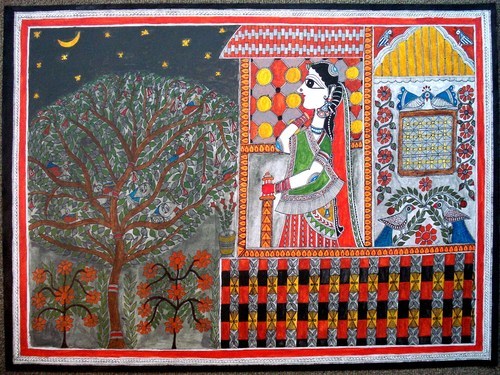
Gazing a the Moon 22"x30" 2011
Though Indian society has begun the slow shift towards women’s rights and inclusion, most women still face a very restricted lifestyle. The woman in Gazing at the Moon has all the riches any person could want: fine clothes, a beautiful home and jewellery. However, this wealth mean little to her in the absence of freedom. From inside her gilded cage, she sees the moon, shining in a limitless sky, and desires the same.
Not only do centuries of social constraint stand in the way of women acquiring freedom but so do economic conditions. Men are often forced to leave and look for work in other towns or even states.
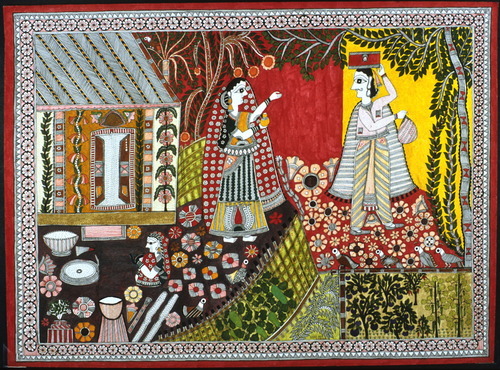
Husband Leaving 22"x30" 2010
Work migration is not a new problem, nor is it limited to the poorer states in India, such as Bihar. Whatever the cause, high unemployment leads to work migration. Although this used to be exclusively a lower caste issue, upper castes are now experiencing the same pressures created by under or unemployment. The wives of migrant workers in India face certain social constraints that add further complications to a difficult situation. While working with an NGO called ACTED, Rani Jha witnessed the fallout of work migration on the wives and families left behind. In this piece, the wife bids goodbye to her departing husband with the requisite pot of water in her hand. She prays that flowers will be at his feet, that no troubles will befall him while he is away. But there is no guarantee of his return. She may grow old waiting, and she will never be allowed to remarry.
One of the dangers faced by women in India comes even before they are born. The abortion of female fetuses is all too common. In Abortion Clinic (below) Rani Jha notes that the doctor is “more dangerous than a cobra”. Here an abortion can be had for 5000 rupees (about $100) and young wives are often forced to abort female babies by their in-laws.

Abortion Clinic 22"x30" 2010.
In
Female Infanticide (below)
the top two panels show the abortion of female fetuses that leads to a population imbalance of males to females. In the lower panels, Rani Jha depicts the resulting competition for mates that leads to violence against women.
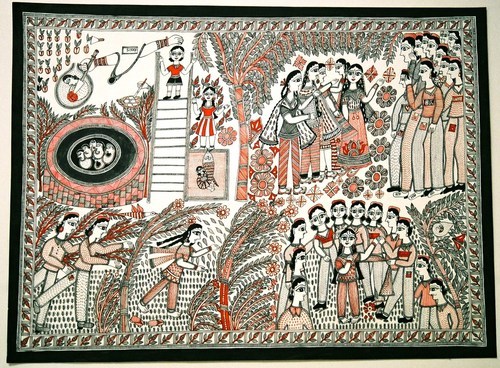
Female Infanticide 22"x30" 2010.
This painting is a follow up to the painting titled Abortion Clinic, and depicts the ripple effect of female infanticide in India. In 2006, an article appeared in a Delhi paper which told of the discovery of a half dozen female foetuses found in a dry well. After reading this article, Rani Jha responded by creating this tableau. In it, she describes the opportunities given to boys (shown on a ladder) and the oppression and obstacles faced by girls (represented by the cobra coiled beneath her). She goes on to demonstrate the long-term effects of gender imbalance on a society such as aggressive behaviour, human trafficking and rape. The implication of the lack of potential mates for so many men cannot be understated. It is a natural impulse for most people to desire sex, companionship and family. Subversion of these desires leads to abnormal behaviour.
In Changing Women Rani Jha uses women’s dress to illustrate the change in societal norms over the last half century resulting in greater freedom for women.

Changing Women 22"x30" 2011 .
Marking the generational changes from 1940-2010, the piece Changing Women shows the easing of restrictions traditionally placed on Indian women. Moving from right to left, the traditional Indian woman is shown with her face veiled, surrounded by eight children, and wearing lots of jewellery. The next generation of women did not shroud their faces, though her hair is still mostly covered; she is also still heavily adorned, but only bore four children. In the next panel, the woman wears her sari over her shoulder and her hair in a bun; again, this generation produced fewer children. In the last panel, the contemporary Indian woman is not wearing sleeves, and her hair and face are uncovered. She carries a mobile, and can be seen out in the world. Also, she wears a wristwatch in the place of many bangles. This woman has only one child and, significantly, it is a girl. Gender selectivity is often a prominent social issue in Rani Jha’s work, and this piece is no exception.
With change however also come problems. As young married couples seek their own space, both physically and emotionally, elder parents are forced from the home.
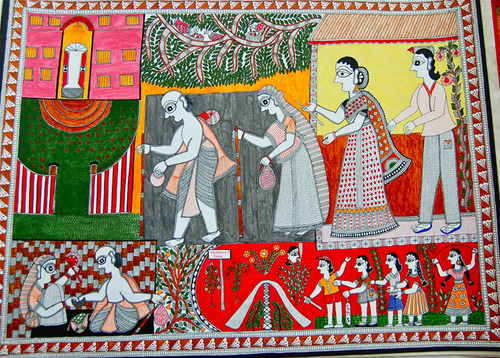
Parents Forced from the Home 22"x30" 2012
This piece depicts the burgeoning plight of senior citizens in modern day India, who face the collapse of the traditional joint family model. Young couples, seeking what they believe is more freedom and space, are increasingly forcing out their elders from their homes. Due to a lack of retirement homes, many such seniors end up homeless. In the joint family model, the grandparents fulfil several roles, including providing care and companionship for their grandchildren. They teach them life lessons, and develop their creativity and morality through storytelling. Children raised this way are more apt to become well-adjusted and productive citizens. However, the lack of multi-generational influence erodes the values of the next generation. In her piece Parents Forced From Home, Rani Jha depicts an elderly couple being ejected from their son and daughter-in-law’s house. The retirement home is full, so they wind up on the streets. In the absence of the grandparents, the children develop bad habits like smoking and go unsupervised in their play.
We complete this post on the paintings of Rani Jha with Two Women which depicts a quiet and necessary moment away from the stress of daily life.

Two Women 22”x30” 2011.
Companionship is an essential part of a healthy life; the trust and intimacy found between two female friends is different between a man and wife. Sometimes, a confidante is needed: someone to listen and care without judgement or fear of gossip. Without this type of respite, humans may manifest all kinds of physical or psychological maladies. In Two Women, the friends sit within a closed and quiet space, surrounded by vegetation, far from all other society. It is their space alone.
Rani Jha, Cheyenne Bsaies, and Peter Zirnis Madhubani, India and Jersey City, NJ
14 notes
·
View notes
Text
Mithila Art: A Group Exhibition at Tachair
If you missed the Mithila art exhibition at Tachair Bookshoppe in Jersey City in June, this is your chance to visit it here.
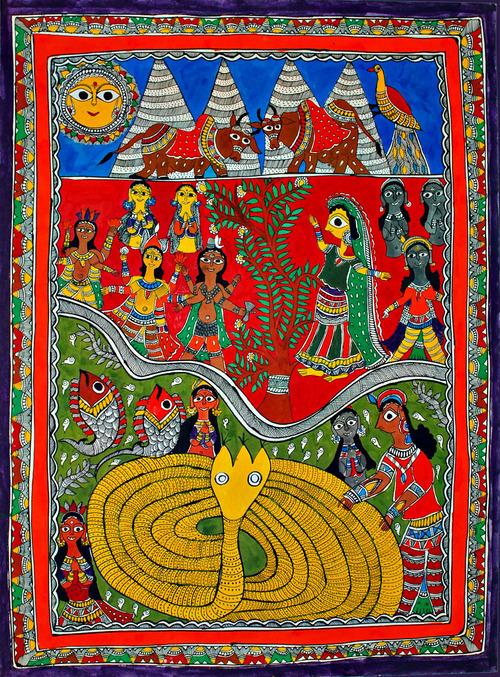
Gauri Devi Krishna Kalliya 30"x 22" acrylic on handmade paper 2010.
A charming rendering of the Krishna Kalliya story with the painting divided into three horizontal panels. The sun and white mountains against a blue sky serve as the backdrop to Krishna subduing the great snake as the excited villagers watch in the center.

Bibha Das Chait Festival 22"x 30", acrylic on paper, 2010.
This is a finely drawn work of the two day festival to the Sun god. At the end of the first day, women with trays of offerings stand in the water facing the setting sun, and again, before dawn the next day, they repeat the ceremony to the rising sun.
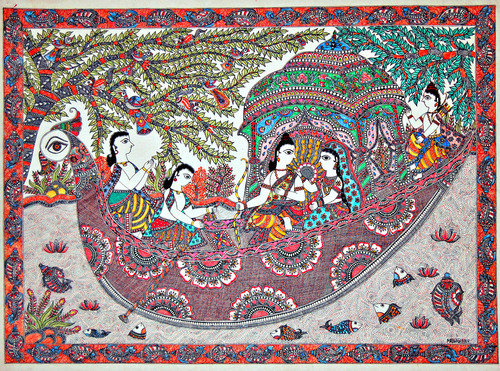
Priyanshu Rama, Sita and Lakshman in Exile 22"x 30", acrylic on handmade paper, 2011.
In Priyanshu's idealized exile of Rama, Sita and Lakshman in the forest Rama with his bow sits next to Sita while Lakshman, a quiver over his shoulder, remains in the back . The work is so delicately drawn it appears almost like lace on paper.
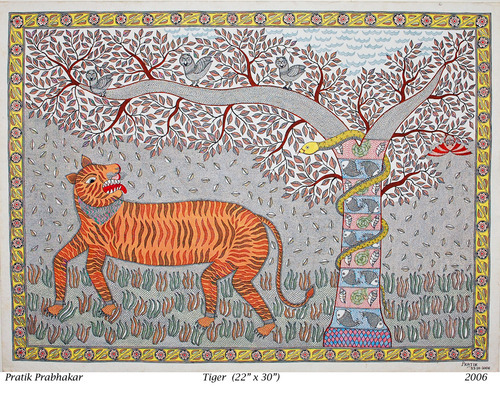
Pratik Prabhakar Tiger 22"x 30", acrylic on handmade paper, 2006.
In this early work by Pratik, the Tiger turns back to snarl at the snake while making a prudent retreat. Note the wonderfully decorated tree trunk with its aquatic animals from the ponds of Madhubani. One visitor to the exhibition wondered if the snake was a Biblical reference - a cross cultural interpretation of standard imagery.

Pinki Jha Marriage Kohbar 22"x 30", acrylic on paper, 2008.
Pinki's talent to take a standard motif and make it seem fresh is clear here in her combining the auspicious fish and turtle images in the center of the lotus pond to create the customary female face that the lotus represents.
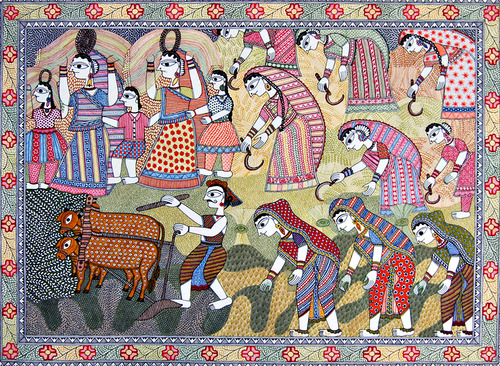
Sudha Devi Harvest 22"x 30", acrylic on handmade paper, 2011.
Sudha Devi is part of the Ranti Village Women's Cooperative which not only makes commercial products on order but also turns out some beautiful unique pieces. This work appears to show both the planting and the harvesting in the one painting.
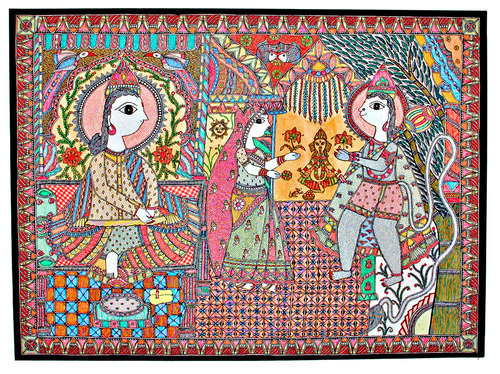
Arti Kumari Rama and Sita Welcome Hanuman 22"x 30", acrylic on handmade paper, 2012.
A highly decorative and colorful painting from the Ramayana story - perhaps the moment when Rama has won the battle against Ravanna and sends Hanuman to fetch Sita.
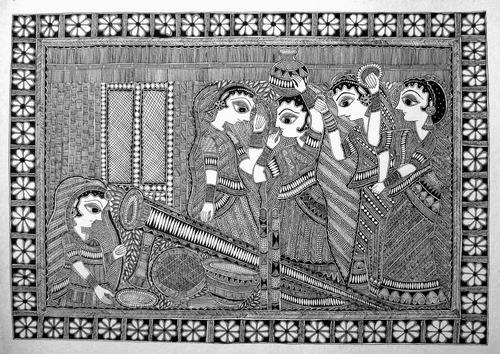
Swati Kashyap Women Grinding Corn 22"x30", acrylic on handmade paper 2010.
A striking composition in black and white in which the women look like dancers on stage. They grind corn by stepping on one end of a long pestle and then letting it drop into the mortar filled with corn.
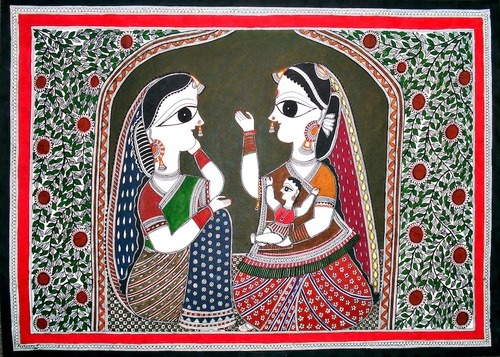
Rani Jha Two Women 22"x 30", acrylic on handmade paper, 2011.
Rani Jha's paintings depict the daily life of women in the patriarchal society of Bihar. Here two women have a quiet exchange away from the pressures of their everyday lives.

Urmila Devi The Tree Goddess 30"x 22" acrylic on paper 2011.
Urmila Devi paints this work in the repetitive 'tattoo' style adopted by the early lower caste painters. As a child she enjoyed working in the fields with her mother and took special delight when the wind rustled the leaves in the trees. Her mother told her that was the goddess of the tree singing and here Urmila Devi paints the goddess against the trunk of this Tree of Life.
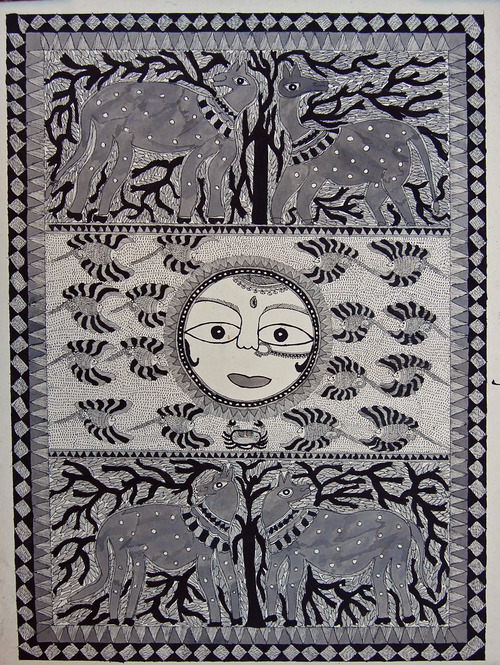
Attributed to the late Lalita Devi of Jitwarpur but the various signatures on the back make this improbable. Night Scene 30"x 22", acrylic on paper, purchased 2012 in Jitwarpur.
The painting, an adaption of the tattoo style, is representative of a motif popular among village painters.
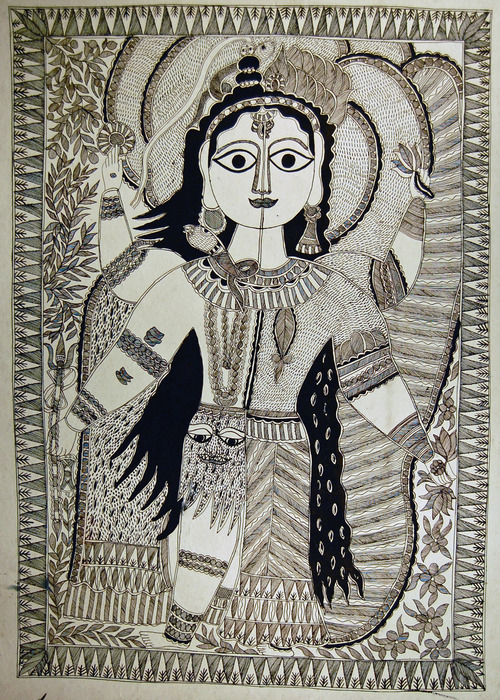
Anonymous Ardhanarishwara ( Shiva and his consort Parvati share one body), no date, purchased 2011 in Madhubani. 30"x 22", acrylic on paper.
The sexual duality of the Shiva/Parvati figure reflects the feminine philosophical concept that the male (matter) is powerless without the female (energy), thus the great god Shiva is powerless without Parvati, his shakti (energy) .

Arti Kumari Woman in the Role of Mother Nature 30"x 22", acrylic on handmade paper 2011.
Arti Kumari painted this piece to depict the importance of the feminine both in daily life and in the cosmos. Despite the patriarchal and conservative nature of Bihar society there is a powerful undercurrent of feminism in the work of many of these artists.
This was the exhibition at Tachair. There was great interest in the exhibition and despite a rainy and stormy night for the opening we had good attendance and all stayed late. If you have any questions on the work feel free to contact me at [email protected].
1 note
·
View note
Text
The Tantric Gods of Krishnanand Jha
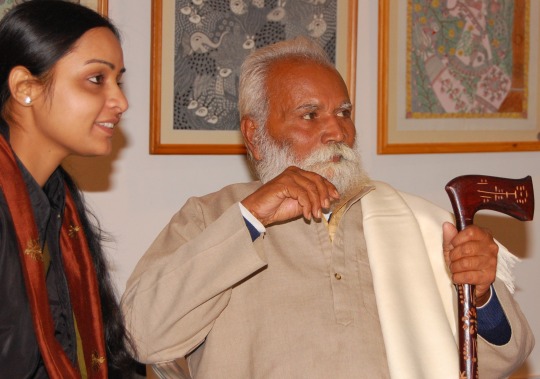
Krishnanand Jha (right) with the Mithila painter Amrita Jha at Arpana Caur Academy of Fine Arts and Literature in New Delhi, Feb1, 2013.
Krishnanand Jha's art is like that of no other Mithila painter. Perhaps that's not surprising for someone who didn't set out to be a painter. When he couldn't find a job after graduating college, he decided his diploma was worthless, tossed it into the Ganges and turned to painting.
Krishnanad Jha's grandfather was a Tantric priest and his father practiced Tantra. Although he himself is somewhat ambiguous about his Tantra practices, much of his work consists of paintings of individual Tantric gods, and his family goddess Chinnmasta, a powerful shakti (feminine power) goddess, is worshipped according to Tantra rituals.
Here is an excellent example of his work from the 1980's : the eighteen armed Anand Bhairav , 22"x30", a fierce aspect of Shiva as Lord of Destruction.

An absolutely stunning composition that exhibits Krishnanad Jha's unique style at its best: the imposing figure of Bhairav is barely contained by the picture space. Our attention immediately centers on the white angular faces, in profile, with their large Mithila eyes, and then the arms, branching out from the body, nine on each side, white like the faces, the whole forming a circle against the pastel green of the background. The effect created by these faces and wide open arms is captivating and dominates the rest of the painting decorated with repetetive designs and pastel coloring.
Krishnanand Jha's representation of gods and humans in these early 1980's paintings is very particular: his figures are elongated, large, with much too small, almost stunted legs and feet, as in this painting where a child-like leg appears at the bottom of Bhairava's robe. Note also Bhairava's profile, forehead through nose drawn as half a triangle, a characteristic of Krishnanand Jha representation of the face.
Next, The Tantric Guru "22x30". A guru, not a god, but painted in the same style. Krishnanand Jha said that while working on this painting he had in mind the Tantric gurus who guided him when he was younger.
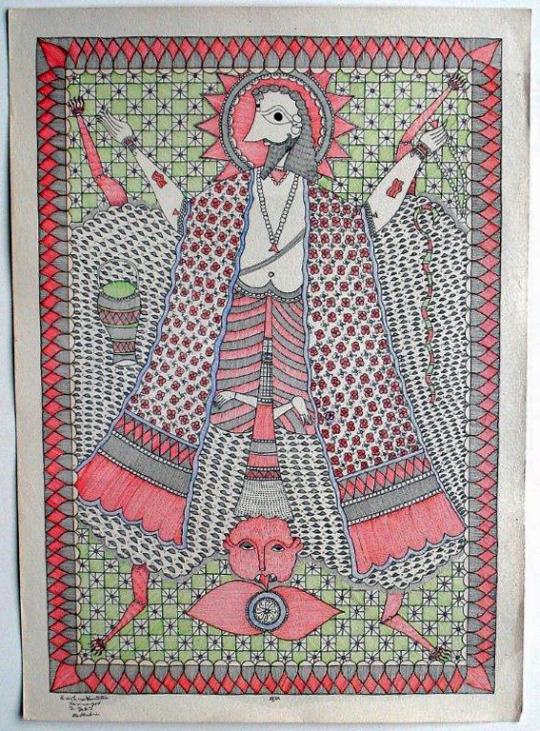
With upraised arms marked with the sign of Shiva, a Tantric guru of Kundalini yoga sits in lotus posture on a tiger skin, his begging bowl beside him. His upper torso with sacred thread and prayer beads is white, as are his face and arms while his robe decorated with small red flowers sets itself off from the dark repetitive markings of the tiger skin. The tiger's head and protruding tongue are at the bottom of the painting while the tiger's feet and claws, characteristically dwarfed as are the legs of the guru, extend into the four corners.
The Tantric Goddess Dakini whose assistance is sought in Kundalini yoga. 22"x30".
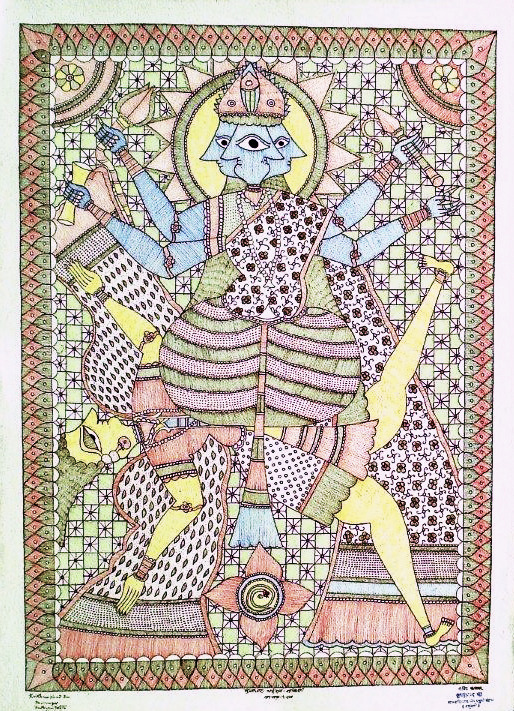
The goddess Dakini is always portrayed with three heads and four hands according to Krishnanand Jha. With a lotus, a manuscript, and a weapon in three of her hands while the fourth is empty, the goddess stands on the prone figure of the great Lord Shiva. We are in the world of shakti, female power, where it is the feminine not the masculine that is worshipped. At the bottom of the painting, the coiled snake in the lotus tells us we are dealing with a Tantric goddess of Kundalini yoga. The snake represents dormant psychic, spiritual energy, that can be awakend through meditation and other practices with the help of the goddess. Once awakened, the energy uncoils and travels upward from the base of the spine through various spiritual and meditative stages untill it reaches the crown of the head to produce a mystical relevatory experience of self-realization, sometimes thought of as the union of the goddess with Shiva.
In this painting Krishnanand Jha abandons his practice of leaving the figure white to stand out against the color and decoration of the rest of the painting. Both goddess and god are important here so both are equally painted in color though Dakini with her blue color and position at the top of the painting is given prominence as befits the narrative.
The goddess Durga without her lion mount. 22"x30".
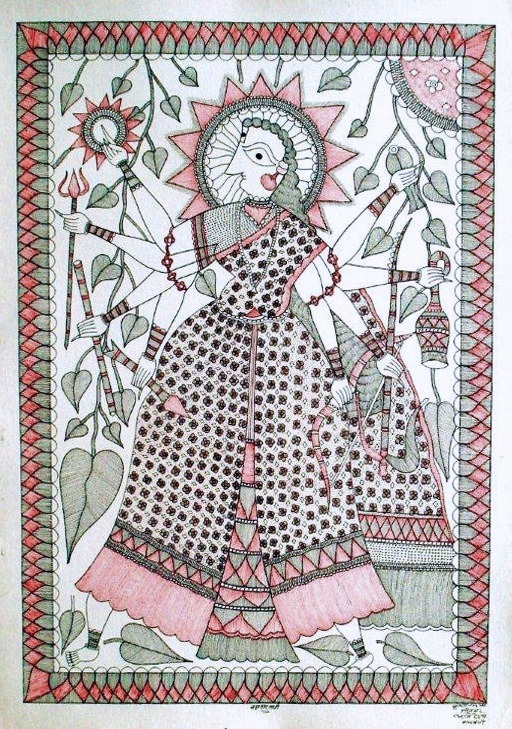
This painting is quite different from the previous single figure paintings. The goddess Durga with colored dress, wrist bands and starred halo is here set against a white background. Two vines with black and white leaves, their thin parallel lines drawn with a very fine nib, descend from the top, one on each side. The piece is striking with the eight armed goddess, weapon in each hand, filling the entire frame, yet it is also oddly peaceful perhaps because of the white background and simple decoration.
The very fine lines of the leaves bring to mind a conversation with the artist Rambharos about his studies with Krihsnanand Jha. He mentioned that the older artist was never satisfied with the line made by the nib pens he bought commercially but would always whittle the nibs down to achieve varied thicknesses of line.
Another example of Krishnanand Jha's 'white background' style - this time in a three figure Ramayana painting, Rama, Sita and Lakshmana 22"x30".
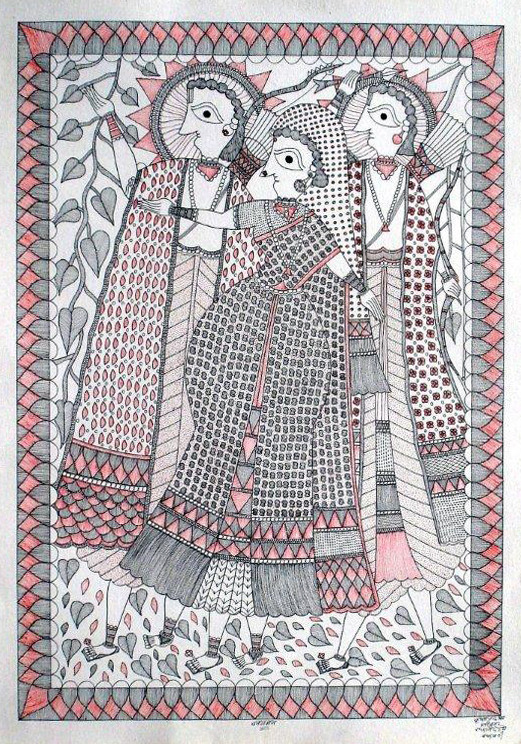
The force of this painting comes from the simple, pared down figures, and repetition, either of decorative elements or of the figure itself. The faces are the same except for Sita's nose ring. And though both Rama and Lakshmana have halos and Sita doesn't, her sari with its large curve over the top of her head serves the same visual purpose. Allowing a slight difference for Sita's feminine dress, their clothing is also similar. The repetitive figures draw our attention to the decoration - particularly the play of the various designs and colors on the wide border at the bottom of their dress. There is enough difference for the eye to take enjoyment but not so much that we have to strain to make sense of what we are seeing.
The repetition also makes certain variations significant, even dramatic, as in the gesture by Sita, her arm thrown forward as if indicating the direction these travellers should take.
The Trimurti - Brahma, Vishnu and Shiva - responsible for the creation, maintenance and destruction of the world. 22"x30"
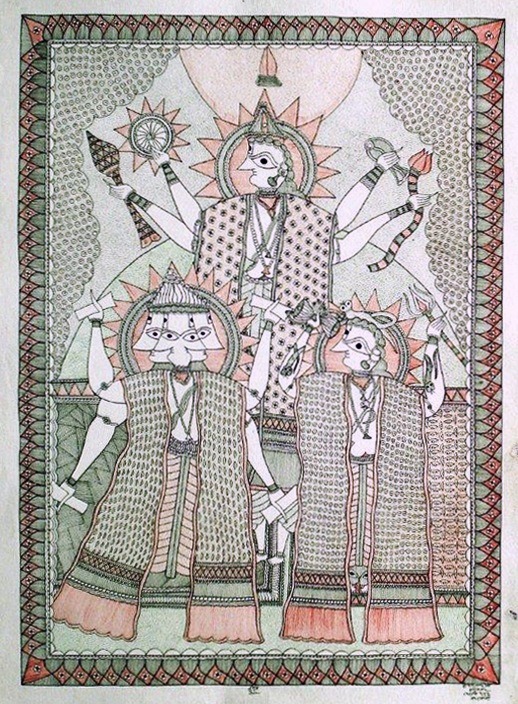
A very effective composition. The three gods present an imposing scene as rulers of the universe. The repetion of the simple geometric form despite differences in decoration, despite Brhahma's four faces, creates a powerfull impression on the viewer. As if onstage, curtain drawn back, these almost totem-like figures exhibit their power as they reveal themselves to their worshipers.
I would like to finish with a painting that holds special meaning for Krishnanand Jha: Chinnamasta and Baglamuki, 22"x30".
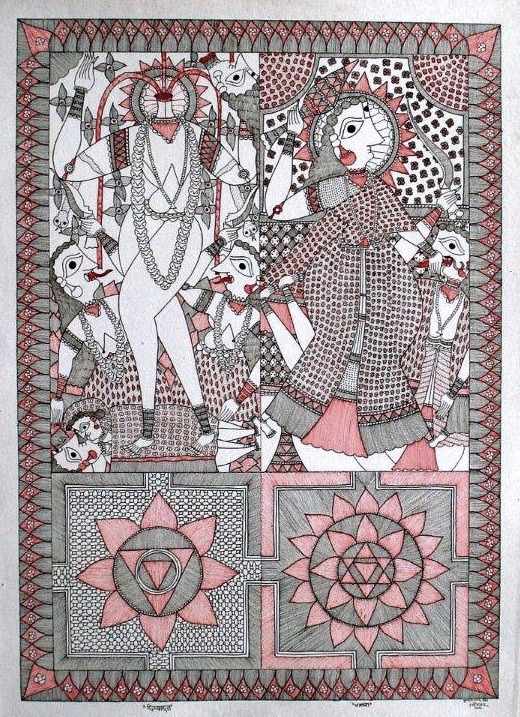
These are two of the ten Mahavidya (great wisdom) goddesses who are manifestations of the Great Goddess envisioned and worshiped as the Supreme Being of all existence.
Chinnamasta is shown holding her severed head in one hand while standing on a copulating couple. Three streams of blood spout from her neck, one into her own mouth and the other two into the mouths of her two followers. In simplest terms, Krishnanand Jha says she represents the destructive and generative principle of the world. The other goddess, Baglamuki, is the goddess who releases individuals from their spiritual misconceptions and also defeats their enemies. She is shown pulling the tongue of a demon with one hand while preparing to crush him with the club she holds in the other. The yantra diagram painted below each goddess is necessary for the proper execution of their worship ritual.
Chinnamasta is special for Krishnanand Jha. She has been his family's goddess for hundreds of years and he continues the tradition. There is a special room in the house for her and she is consulted before any important decision. On those occasions Tantric prayers are said, a he-goat is sacrificed, and the entire family eats this sacred meal. He says he often paints the Mahavidyas because these paintings bring him peace and help him deal with spiritual and mundane problems in his own life.
Krishnanand Jha has suffered from Parkinson's disease for over a decade and now no longer paints. At the Ethnic Arts Foundation's exhibition of Mithila Art: the New Generation in New Delhi this February, 2013 he was honored for his life's work and there is a celebratory volume of his paintings in preparation.
4 notes
·
View notes
Text
Satyameva Jayate: Bollywood and Mithila Art
Satyameva Jayate has India all abuzz. It's a weekly TV talk show hosted by a Bollywood super star that examines social issues such as female foeticide and the dowry system- practices deeply ingrained in Indian society - with unusual frankness and much publicity.
The women artists of Mithila welcome Satyameva Jayate to their long struggle. They have been producing paintings on injustice to women for over 20 years, at least since Lalita Devi painted the militant goddess Durga with pots and pans in her hands instead of her battle weapons. "People look for Durga in the sky", she said, "but don't see the working Durgas all around them".
Today, of the many artists in Madhubani who paint on women's suffering, there is no one who does so as steadily and with such pictorial success as Rani Jha.
Here is her Abortion Clinic 22"x30" 2005.

The anemic blood red color and the female doctor, more dangerous than a cobra Rani Jha says, set the tone of the painting. Our disquiet grows as we become aware of the various pieces in the story - the discarded fetuses, the sharpenend scissors, the syringes, the surgical glove, the 5,000 rupee note - the local cost for an abortion. The doctor and uniformed nurses work with clinical precision to fulfill society's demands. In the foreground a woman sits hunched over, arm wrapped around her knees and weeps.
With The Husband Leaves 22"x30" 2005 Rani Jha treats domestic relations.

The piece is stunning in color and visually arresting with its flattened perspective and top down view. It appears to be a scene of domestic perfection - the flower garden, fruit trees, the decorated facade, the neatly arranged cookware in the front yard. But then we notice that the woman is crying and the child is withdrawn, her back to the adults. The father is leaving. With a sack in one hand and a suitcase in the other, he walks through the flowering garden and is gone. The painting is based on a popular song about the exodus of Bihari men to other parts of India to look for work. Some never return.
While Rani Jha seems to mask her concerns with the beauty of her work as if she feels society is not yet ready to face these issues directly, Rupam Kumari, who was 17 years old at the time, had no qualms about being direct in her painting of bride burning for dowry. Drawn in a quick, rough style, she tells the story of a young girl's short journey from wedding ceremony, to suffering daughter-in-law, to being doused with gasoline and set on fire. The husband is then free to remarry and gain another dowry.
Bride Burning or A Woman's Fate 22"x30" 2004

In an innovative, contemporary style Pinki Jha paints a more complicated picture of the dowry practice by showing the participants tied into a system they cannot escape. Although the dowry is technically illegal, it is still expected. Refusal to pay is certain to cause problems with the in-laws and even payment is no guarantee of peace. The upside down figure at the top is the bride praying to Krishna to free her from the torment of dowry much as he freed Draupadi in the Mahabharata epic. At the bottom of the painting the new couple, ritually tied to one another, circle the sacred fire seven times to assure that they will remain together through seven rebirths. Meanwhile, in the center of the painting the dowry chains continue to maintain their iron grip on all the participants.
The Dowry 22"x30" 2004.
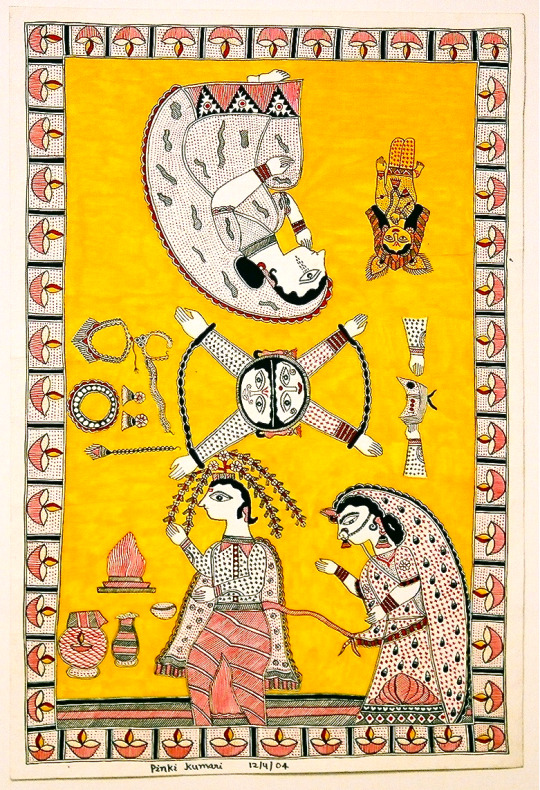
That same year Sangita Kumari effectively used primal colors to tell yet another tragic story of inter-caste relations. We read from left to right of a bright lower caste boy hired as a tutor for an upper caste girl. They are overheard expressing affection for each other and their story is spread at the communal well. The girl's parents insist she marry in her own caste. The wedding takes place but later, in despair, she sets herself on fire. The young man is blamed and attacked by the family. He then also commits suicide. The painting is said to be based on actual events in a neighboring village.

.
Gunjeshwar Kumari Better a Tree than a Girl 22"x30" 2011
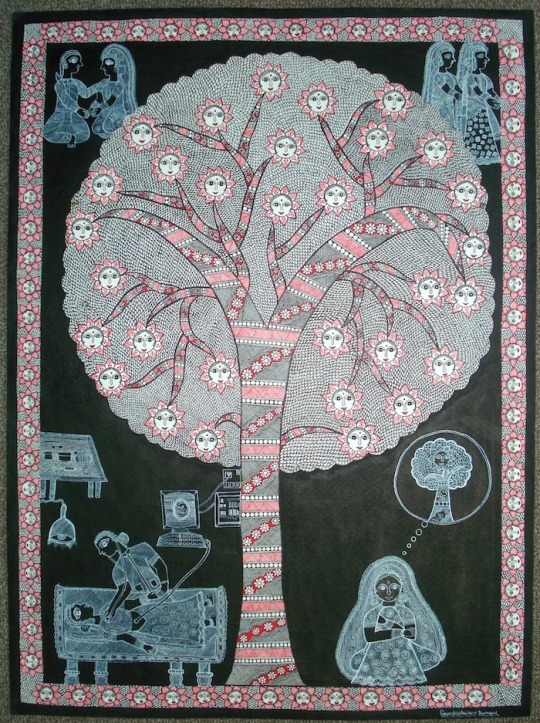
Here a melancholy piece by Gunjeshwari Kumari on the forced abortion of girl babies. Set against a black background, the incised white images, like specters in a nightmare, tell the story of a marriage and the young mother's reluctant abortion of her female fetus. In her sorrow, she sees a tree in blossom with its many pink flowers and imagines the flowers to be the spirits of all the aborted baby girls. It would be better to be a tree than a girl, she muses, because then she would have her baby girl.
Up to now, the paintings, whether subtle or direct in their criticism, are still respectful of societal norms. Today however, with a younger generation, we see a change. Below are two pieces by two different young women who take a new assertive, defiant stance.
Bibha Kumari Woman is Malleable 22"x30" 2012.
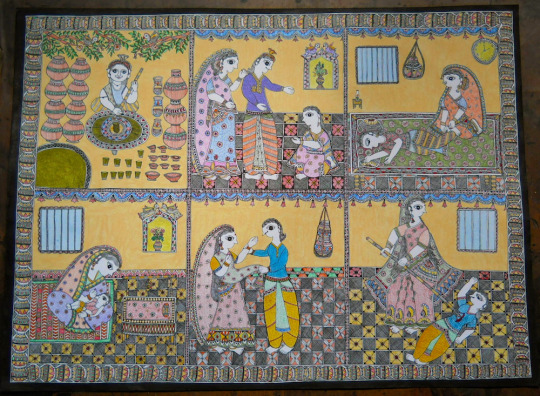
Like potter's clay, a woman will adapt to circumstances and do her duty as daughter, wife and mother. But if attacked, she will fiercely defend herself. The killing of her male attacker is modeled on the standard image of the great goddess Durga slaying the monster Mahisha with a lance at the request of the gods who were powerless before him. The painter's use of this familiar imagery gives the woman's action a religious connotation that emphasis both the validity of the act and the latent power residing in women if they were just to use it.
And finally this radical piece by twenty three year old Supriyah Jha What Should Happen, But Has Not Yet 22"x30" 2011.
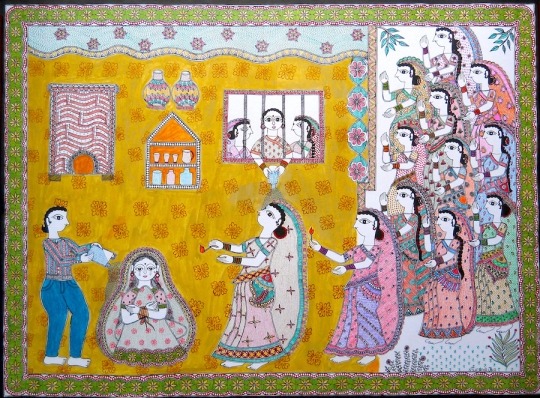
After seeing a student painting on wife burning at the Mithila Art Institute where she was studying, Supriyah became so angry she painted this piece as a response. The husband pours the gasoline and the mother-in-law strikes the match. With her wrists bound, the despondent bride awaits her fate. But now, submissive no longer, like heaven-sent angels in a medieval painting, a procession of women arrives to save the wife and put an end to these horrific acts. They are prepared to set the would be killers on fire! Whether the artist meant for her painting to be taken literally or not, what stands out here is that this is no longer an indictment of society but a clear call to action. Supriyah said she deliberately did not include any men in the group because this is an action that must come from the women themselves.
Both of these paintings go far beyond commentary or criticism of the deadly social injustices that women suffer much too often. The mood is angry and defiant - the paintings demand that things must change and they call upon women to be in the forefront of this change.
There has long been been a feminist awareness among the artists in and around Madhubai. Their paintings gave expression to ideas that the general public was not yet ready to accept. Now with Satyameva Jayate's popularity, these often beautiful and somewhat prophetic Mithila paintings may finally receive the recognition they deserve.
1 note
·
View note
Text
The New Mithila Art Amrita Jha
When I first saw Mithila paintings on the streets of New Delhi a few years ago, I found among the many quickly drawn pieces for the souvenir trade a few that stood out. They were particularly strong, energtic, with a good sense of design and color. Later when I traveled to the Madhubani area, I was greatly surprised by the quality and variety of the work, both in town and in the surrounding villages. I was not prepared for the many paintings that dealt with contemporary social and political issues and for paintings that did not look like Mithila paintings at all as artists sought new ways to express themselves.
The painter Amrita Jha is part of that small group of young, serious artists in Madhubani that is trying to reconcile the traditional with the contemporary. It is already clear from her early work that she was not an artist content to simply follow but was already engaged with the tradition.
Radha Krishna, 22"x30", 2005. Private collection.
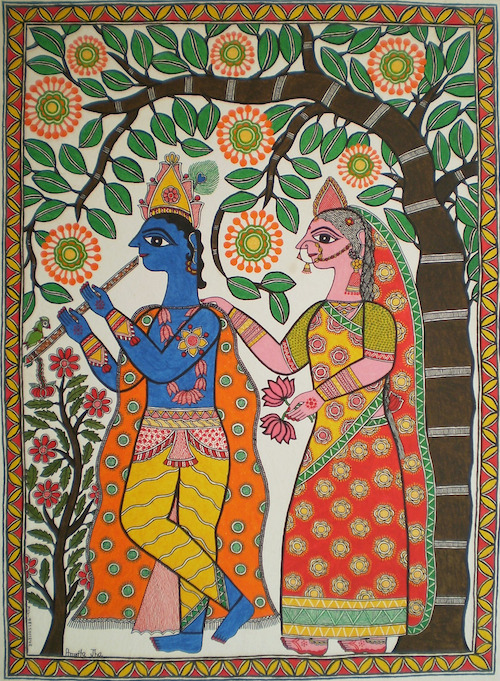
The lines are bold and sure, the colors harmonious. The flowers of the Kadamba tree burst like celebratory fireworks over the loving couple. Krishna in the traditional cross legged stance with flute in hand, Radha behind him. But look at her hand on his shoulder. An assertive gesture, a supportive gesture, not one usually seen in depictions of Radha Krishna. Radha is claiming Krishna for herself as Amrita Jha is claiming this painting tradition for herself.
Below another early piece. The traditional lotus pond. But again, the work is far from a copy of the standard theme.
The Lotus Pond, 22"x30", 2005.
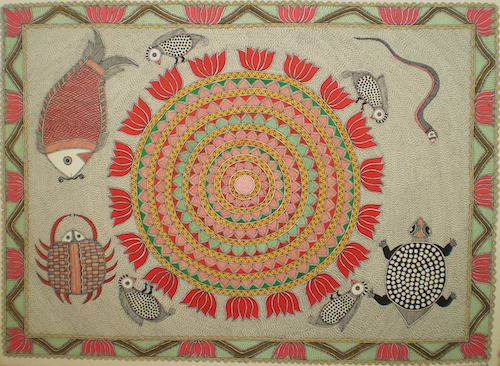
The central lotus, a pinwheel of many concentric circles of similar hue, is dominant and almost hypnotic in its effect while the surrounding pond with its clearly delineated animal figures provides a visual respite from the spinning center. Look at Amrita's work on the wonderfully decorated aquatic animals. They are stylized but their carefully chosen decoration adds an individuality and makes us look closely at each. Careful hatching of the ground adds texture to the work. Click here to appreciate the detailed work.
Two Snails, Ardhanarishwara 22"x30", 2008. Private collection.
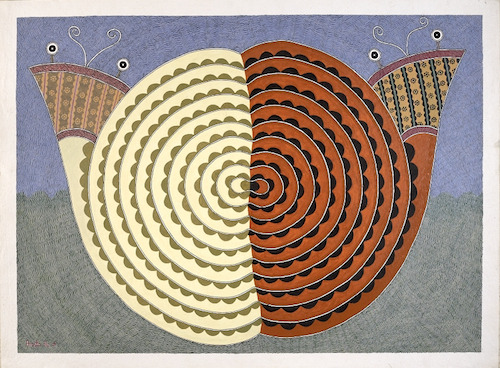
The work is similar in design to The Lotus Pond of three years earlier, but now there is hardly a hint as to its Mithila origins. The cool color palette, the repetitive but simple circular decoration of the snail shell, the hatching of the ground so minute that it gives a soft delicacy to the entire painting, all this contributes to a peaceful, contemplative mood without diminishing the power of the piece.
Although the style is not traditional, Ardhanarishwara is a common subject in Mithila art. It refers to the Indian philosophical concept that male power is dormant without the female energy necessary to set it in motion. In art this is usually expressed by the androgynous figure of the god Shiva and his consort Parvati. Amrita chooses to represent this idea by two snails, male and female, inhabiting the same shell. An example from the world of simple creatures to express a universal truth.
The Lovers 22"x30", 2009.
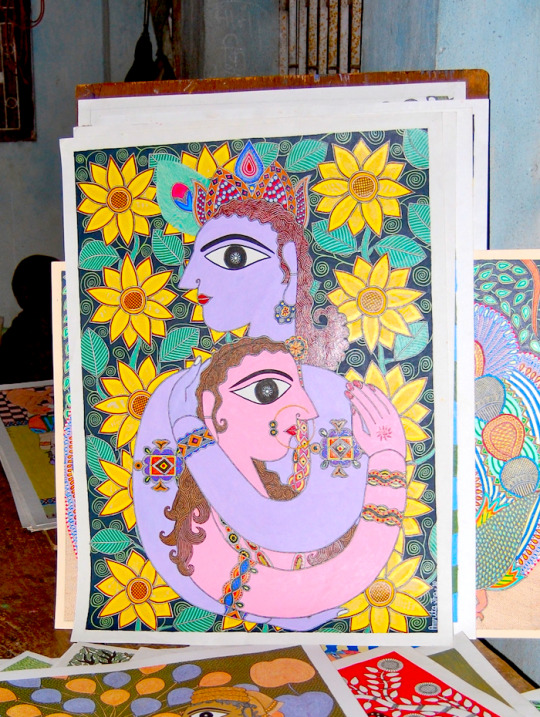
We have left the usual Radha Krishna representation behind. As in her traditional treatment of this theme above, Kadamba flowers frame the work but now there is no place for the subtle gesture of affection or belonging. This painting is direct in its sensuality. Radha rests her head against Krishna's bare chest as their elongated bodies, decorated only with jeweled bracelets, enfold one another. The profile faces and almond shaped eyes indicate a Mithila tradition. The lovers' quiet passion and contemporary treatment however are the artist finding her own way within that tradition.
The Tiger, 22"x30", 2011. Photographed on the roof of Amrita's house in Madhubani, January, 2012.

Amrita is now working in the highly decorative style first executed in Two Snails. The figure fills the canvas and the painting is minutely worked: the brown irises flaked with bits of almost invisible color, the tiger's face marked with soft lines creating geometric shapes of varied hues, stylized patterns decorate its forehead and cheeks while the wonderfully drawn nose and mouth are balanced by the large hypnotic eyes. Though not at all in the usual Mithila style, the piece is reminiscent of the small traditional images of Surya, the sun god, that often decorate the entrances of homes in the Madhubani area.
Surya on entrance gate, Madhubani district, Jan 2012.
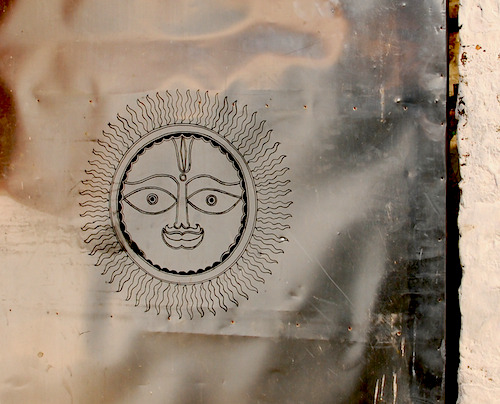
I would like to conclude this post on Amrita Jha with a painting I saw at her home in Madhubani a couple of years ago. It was a damp January evening in 2010 and getting dark. The city had not yet turned on the electricity so Amrita brought out a kerosene lamp.
The Dancers, 22"x30", 2009.
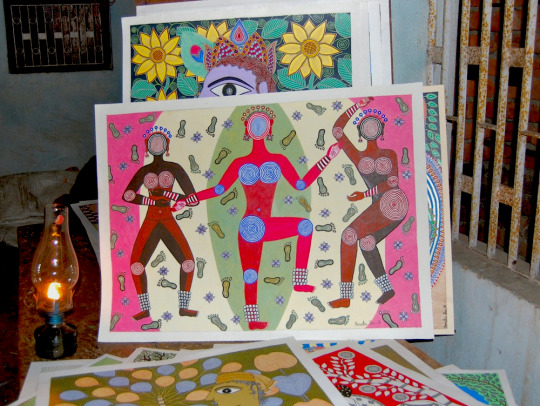
I was taken aback by the work. Nothing I had seen in Madhubani prepared me for this painting. The footprints are dance steps but they also refer to the Devotthan aripan. That is a traditional floor design made with rice paste that depicts the footsteps of the goddess going from the courtyard to the special room set aside for her worship in the house.
Nested ovals frame the outlines of the three female dancers. The central figure in red with tightly painted bluish concentric circles for face and breasts, elbows and knees captures our attention. She faces us directly, confidently, arms open, hennaed palms forward. Her two sister dancers also look out at the audience. All three almost confronting the viewer as they perform the steps of this goddess dance.
In Two Snails Amrita Jha quietly asserted the importance of the feminine in the world of male power. Here the emphasis is on the independence of the feminine. These female dancers are not seeking anyone's approval. They are dancing their own dance, exulting in their own power. It is the artist herself dancing the steps of her artistic journey, an affirmation of her art and of her feminine being. It was with this painting, Amrita said, that she began to seek her own visual vocabulary in earnest.
2 notes
·
View notes
Text
Rural Murals

Decorating a compound in a rural area outside of Madhubani.
This post is the last of three on mural painting. We began in the town of Madhubai with the city murals of Dulari Devi and Abha Das and here we'll take a look at some rural murals.
We left Madhubani and were driving quickly, late for a meeting with a village artist, when we passed the scene in the photograph above. Late or not, we had to stop.
Local women artists were decorating a former art cooperative in Jitwarpur village in honor of the Chief Minister of Bihar who was visiting the area for a few days. These rural murals painted on the walls of homes and buildings are simpler in design than the highly complex line work of Dulari Devi and Abha Das but no less attractive. The figures are well drawn, broadly outlined with little detail, and the empty areas filled in with bold, bright colors.
Below is another mural in the compound. The clean outline and large areas of color quickly define the subject and render it intelligible at a glance even from afar.

This horse and rider is a very lovely piece with its tall, blue rider upright in the saddle, his right hand raised in an authoritative gesture. The fine red cloak and headdress serve as a backdrop to his blue form and indicate he is someone of importance. His regal horse, richly caparisoned, decoratively painted and well groomed with braided tail and combed forelock also signals this is no ordinary rider. I wondered who this might be but we were in such a hurry that I had no time to ask. Normally, blue is Krishna's color but this did not appear to be the god. There are no symbols here to tie this image to Krishna.
But, when further on I saw this unfinished painting, I guessed the blue rider was Moti Ram, the companion of the Dusadh (a laborer caste) hero Salhesh.

This is a beautiful, well designed and evenly balanced drawing of Salhesh mounted on an elephant with his elephant driver. Note the bird resting on his left hand. At first, the work appeared to depict a hunting party, Salhesh with a hawk on his wrist, an appropriation of royalty by the low caste champion. But looking closer it was clear that the bird was not a hawk but a parrot and so the reference was to Salhesh's empathy with nature, the forest and its flowers, birds and animals. The painting however is reminiscent of a royal hunting party and perhaps this was the artist's intention since it provides an aristocratic association for Salhesh. Click here to enlarge.
Along the bottom of the wall is a charming procession of the Salhesh party.
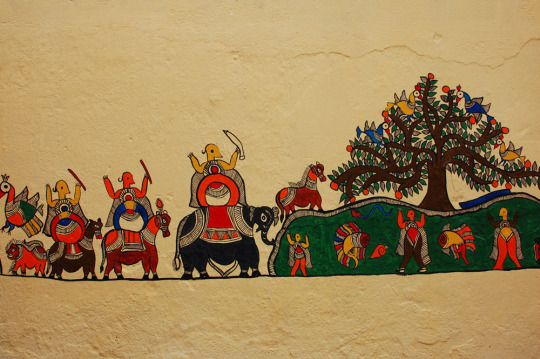
Salhesh in the lead on his elephant is followed by the rest on horseback. They are approaching what might be Salhesh's Garden, a magical place in the forest, with the Tree of Life and parrots in its branches.
Finally, here is a work in progress.
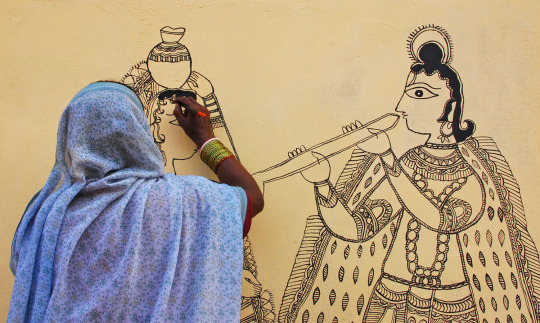
This is Krishna and a gopi (milkmaid), he with his flute and she with her milkpot. There is a little more detail here than in the previous paintings but the decoration is still minimal. The piece seems a bit bland but once the areas are painted in with color the work will become as attractive and pleasing as all the others.
2 notes
·
View notes
Text
Lalita Devi and Her Parrot
Lalita Devi's Parrot:
The Beginnings of the Art
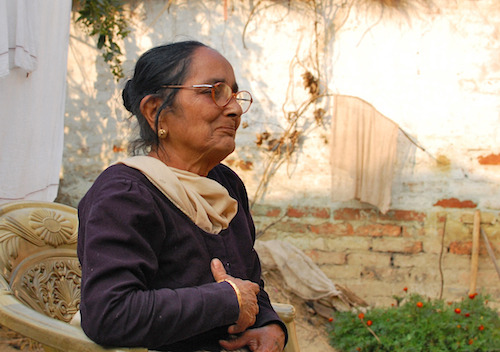
The painter Lalita Devi in Simri village, Madhubani area, Jan 2012.
Rambharos took me to see Lalita Devi, an older painter who had flourished in the 80's and whom he much admired. He remembered her as a very experimental, innovative and lively artist. Today however she was quiet and subdued. I wanted to meet her to ask about a feminist painting she did many years ago showing the many armed goddess Durga with a broom and pots and pans in her hands rather than weapons. "A man told me this was not Durga", she said. "I told him that he keeps looking for Durga in the sky but does not see the hundreds of Durgas around him".
As we continued to talk about her earlier work she became energized and brought out a few of her recent paintings.
Below is 'Krishna breaking the gopi's milk pots', painted in soft tones using natural colors. Although Krishna teasing the milkmaids is a standard theme in Mithila painting, Lalita Devi gives it a feminist turn by making the milkmaid a much more active player than usual in the scene. Her hold on Krishna's ankles is as much a restraining movement as a pleading one.

When we were getting ready to leave I asked if I could take a portrait of her next to a wall drawing of a parrot.
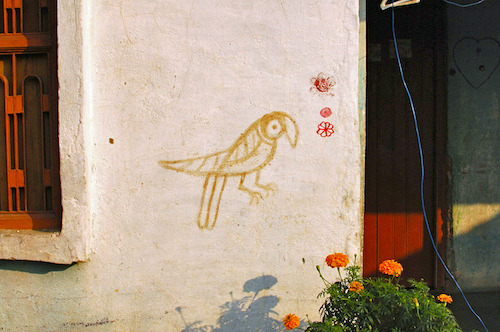
Lalita immediately said that would not do. She asked me to wait a moment, returning in a few minutes with several green leaves in her hand. She had drawn the parrot a few months earlier with leaves like these and would refresh it now. The leaves are from the Sim plant which artists used for the color green before they had store bought paints. Crushing the leaves between thumb and forefinger she began carefully but quickly to paint over the lines of the faded parrot.
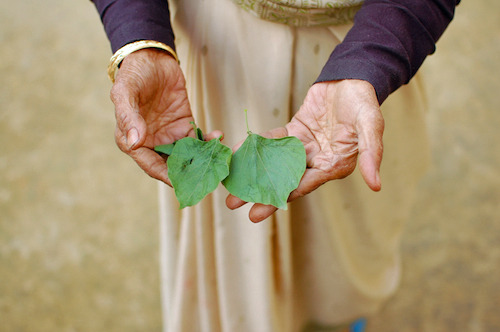

________________________________________________________________
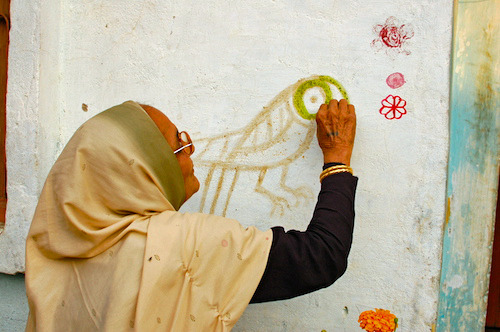
________________________________________________________________

________________________________________________________________
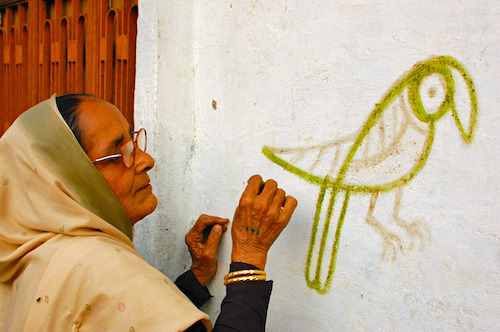
________________________________________________________________
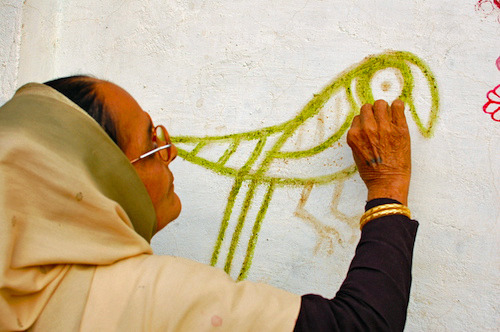
________________________________________________________________
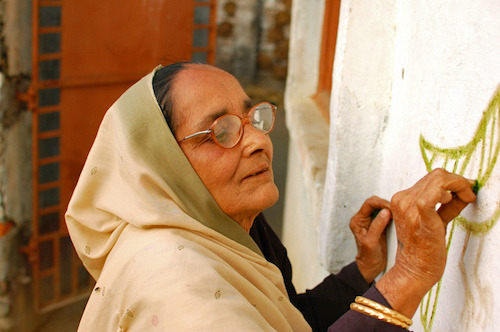
________________________________________________________________
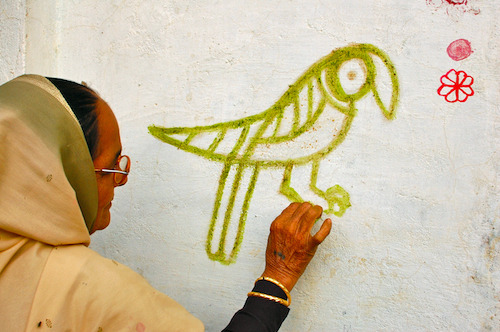
She adds the finishing touch to her parrot drawn with the crushed Sim leaves.
Lalita Devi may not paint very much any more, but this act of painting was a wonderous thing to see. Rambharos and I both watched with a sense of history and a sense of participating in a timeless ritual. Mural painting is the origin of the Mithila painting we now have on paper. And here we had just witnessed the beginning of mural painting.
I had wanted a portrait of Lalita Devi. What better portrait could I have of her than this!
Peter Zirnis Jersey City, March 2012.
2 notes
·
View notes
Text
Murals: The Origins of Mithila painting
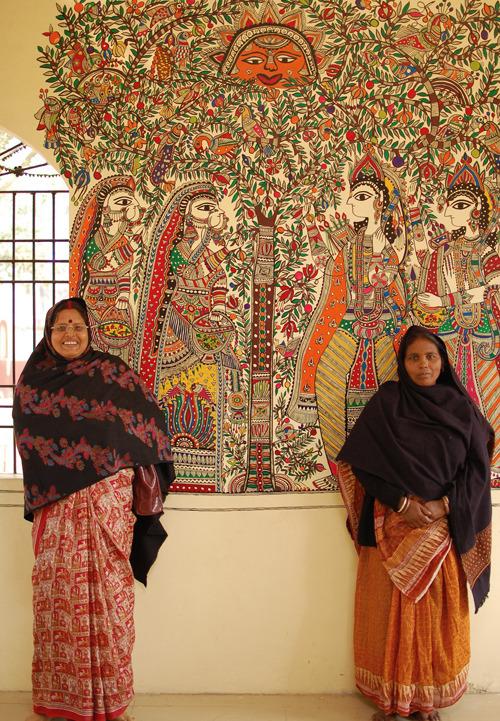
The city of Madhubani commissioned a series of murals based on the Ramayana for its memorial building honoring the 14th century national Maithili poet, Vidyapati. Here Dulari Devi (right), whose work I've written about previously, and Abha Das (left) stand in front of one of their panels. Madhubani, Jan. 2012.
Although Mithila artists now paint primarily on paper, they sometimes do get an opportunity to return to the origins of their art and work on a mural. On last month’s visit to Madhubani I was lucky enough to see three such examples. One was in Madhubani itself where Dulari Devi and Abha Das were working on a sophisticated series of panels on the Ramayana story. The second was at a rural women’s cooperative where the artists were busy decorating buildings with beautiful, colorful murals quite different in style from those of the city. And the third, in Simri village, where I watched with wonder and a sense of history as Lalita Devi carefully sketched a parrot on her courtyard wall using only a few crushed green leaves for a paint brush. In this post we'll look at the Ramayan murals in Madhubani. The next post will cover the 'rural' murals and Lalita Devi's wonderful painting demonstration.
The City Mural: Here is a detail from the above Ramayana mural. Although 'detail' is relative here since I estimate this to be about 4 or 5 feet high.

This is a masterpiece of color and design with its myriad decorative detail creating an exciting visual energy in the work. Rama and his brother Lakshmana, one behind the other, are almost identical in stance, dress and ornament. It is the color of their dress and the details of their ornamentation that sets them apart. Dressed in royal finery with caps and well wrought earrings, throat and upper body covered with jeweled necklaces and garlands fashioned from precious stones, decorative bands at wrist and elbows, they are imposing figures. Beautiful long robes cover their shoulders and flow down to the ground while their diagonally striped dhotis and contrasting sashes complete their regal appearance. Even their weapons are finely fashioned with intricately decorated quivers, colorful arrow heads, and bows inlaid with polished gemstones. These are truly the god-like figures they are meant to be.
Dulari Devi has come a long way from the menial labor days she describes in her painted autobiography Following My Paint Brush. She is now an accomplished painter, and in mural painting perhaps without equal in the Mithila area.
Murals in Progress: I was happy to see that some of the Ramayan panels were still being completed while I was in Madhubani for this allowed me to see mural painting in progress. Below are a number of unfinished panels. This scene appears to be the breaking of Shiva’s bow by Rama, with Ravanna, the ten headed demon king, symbolically looking
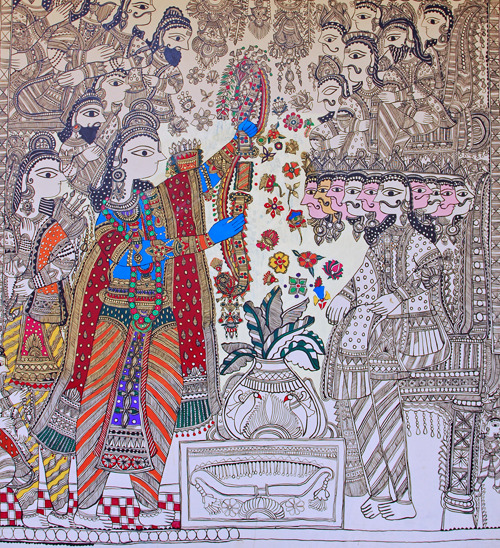
Look especially at the flowers in the center of the piece. Note the soft shadows of the underdrawings that appear to have been painted over when the artists changed their design.
The mural is elaborate in detail and patterning with almost no space without some decorative element. Rama and Lakshmana are again similarly represented in their royal dress, although here Rama is significantly the larger figure as befits his important status. Notice that when the detail is as filigreed as it is in these sophisticated, what I am calling ‘city’ murals, how important color is in helping the eye make sense of the myriad details and lines. Glance at the group of spectators at the top of the mural. Except for their eyes they all blend into a confused if interesting crossing and hatching of lines. Or look at Lakshmana. Where color has been added, we easily differentiate and enjoy the various items of dress while the rest disappears in a multitude of small lines and white spaces.
Next is a section of a mural in its very early stages

. We can see the mural in progress as we look from left to right. The preliminary outlines are painted in a light color and then later painted over with a stronger black line like that on some of the figures on the right. That is also when the details are added and any black areas filled in.
Below Dulari Devi works on the outside wall of the small Vidyapati memorial building.

One can clearly see her materials of rags and newspaper, her store bought acrylic paints and half a dozen brushes of different size. The Mithila artist Rambharos told me that Dulari does not test her colors on a pallette but prefers to use her hand. A quick dab on the palm to see whether the color is right.
Shiva's Bow in the Ramayana: Through the bars of the window above the mural Dulari is painting, one can see the top of another mural inside the building.

This is the famous incident in the Ramayan story where Sita, future wife of Rama and the adopted daughter of King Janaka, picks up the bow of the god Shiva. It was so heavy that no man could lift it. To Janaka's amazement Sita, while cleaning one day, easily lifted the bow out of her way. It was one more sign to the king that his adopted daughter was no ordinary mortal.
Please feel free to comment.
6 notes
·
View notes
Text
Her Story: Sita
You open the book. After a couple of delightful pages with small oval portraits of the cast of characters set against the black paper, the next page is blank. Both pages facing you are solid black. A field of black, dark charcoal. As your eyes move over the two empty pages you notice, in the lower right hand corner, a small white rectangle as if cut out from a typed sheet and pasted onto the black page. The text reads: "For a thousand years the Dandaka forest slept." A shiver of anticipation. This is going to be great, you think. You turn the page, the story begins, and you are not disappointed.
This is Sita's Ramayana, a retelling of the Ramayan, India's great national epic, in graphic novel form. Based on a 16th century Ramayan by a Bengali female storyteller, Sita tells her version of the Rama and Sita story, their exile, her abduction by the demon Ravanna, Rama's long battle to get her back, and then, after victory, his rejection of her.
Published by Tara Books, this graphic novel is a highly successful blending of image, text and design. Bengali artist/storyteller Moyna Chitrakar's paintings, Samhita Arni's text and Jonathan Yamamaki's design come together to create a dramatic, exciting, and poignant story that invigorates an epic most people familiar with the tradition think they already know.
Below is Sita in captivity, longing for Rama.
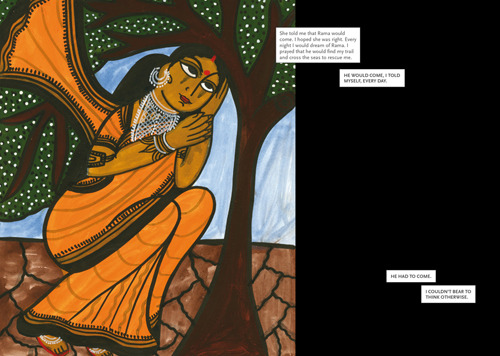
Visually the image is arresting. Sita, like a sorrowful angel in some early Italian painting, her sari billowing against a starry sky of white buds on somber trees, anxiously waits for Rama to rescue her. The black expanse of the page adds to the dark mood. Against that black page, the white rectangles lead you down step-like to that final sentence :
"He would come, I told myself, every day."
"He had to come."
"I couldn't bear to think otherwise."
You feel the intensity of her emotion and understand her near despair. Arni's precise use of everyday language along with Yamamaki's graphic design give Chitrakar's traditional painting a modern sense that makes this a compelling scene for the contemporary reader.
Here is Sita waiting for Rama after the defeat of the demon Ravanna.
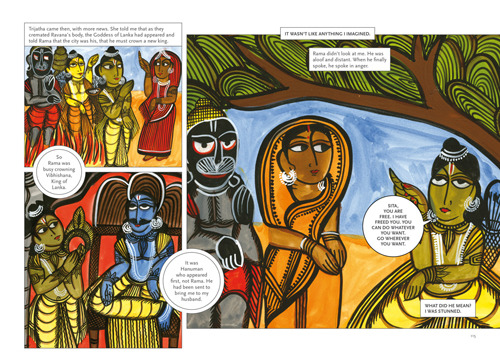
Note again how effectively image, text and design work together to move the story along and show us Sita's emotional state of mind. The two small panels prepare the reader for the long-awaited reunion with Rama while Arni's few sentences signal that all is not well. Ravanna is defeated, but where is Rama. Why has he not come? He is busy crowning a new king. But then, Rama still does not come. Instead, his trusted messenger appears to summon her. Something is not right. At the top of the next panel, the chilling words: "It wasn't anything like I imagined." prepare the reader that the reunion will not turn out as expected. Short, succinct, intense, dramatic. You want to keep on reading.
As I assume you can tell by now, I thoroughly enjoyed Sita's Ramayana. And although the work is obviously not in the Mithila art tradition, I found this graphic novel so fresh and exciting, and some of the images so memorable, that I wanted to bring it to your attention. The book is available in the US from Amazon, among others, and was, by the way, recently on the NY Times best seller list.
2 notes
·
View notes
Text
Her Story: Dulari Devi
"I am an artist, but I wasn't always one." This is how Mithila artist Dulari Devi begins the account of a life that moves from extreme poverty and constant menial labor to that of an accomplished and recognized painter. Following My Paint Brush is her story told in thirty two pages of colorful, autobiographical drawings accompanied by a few sentences that give voice to her images. Published by Tara Books with their usual high quality, the book is in hardcover with luminous white pages and crisp colors that show Dulari's work to good effect.
In the first painting we see Dulari as a little girl accompanying her mother to work in the rice fields. Note the clean lines of her figures and the nearly semi-circular billow of the saris. Although a standard way or representing the sari in Mithila art, Dulari seems to make it a trademark. Perhaps because she often leaves the backgound empty, as in these drawings, the curve of the sari is more prominent than it otherwise would be.
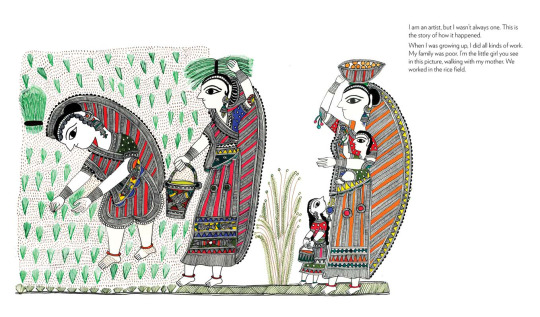
As she recounts in the book, her unhappiness with her life began to change when she started to visualize scenes that she passed everyday as paintings. These images stayed with her during the day and relieved some of the daily drudgery. Then came a stroke of enormous good fortune. She began working as a maid in the home of a successful Mithila artist, Mahasundari Devi. Facinated by the paintings, she asked if she also could learn how to paint. That was the beginning of her new life.
The Ice Cream Man is one of those ordinary scenes that Dulari used to imagine as a painting. This is a happy piece as befits its subject but note the careful, formal structure that supports the simple scene of children buying ice cream. While the tree in the center divides the drawing in two and separates the children on one side from the ice cream man on the other, a canopy of branches with green and yellow leaves interspersed with red berries spreads over and encompasses the entire scene. On each side of the painting a leafy branch reaches down just enough to give a gentle caress to the outside figures and bring them all into the fold.
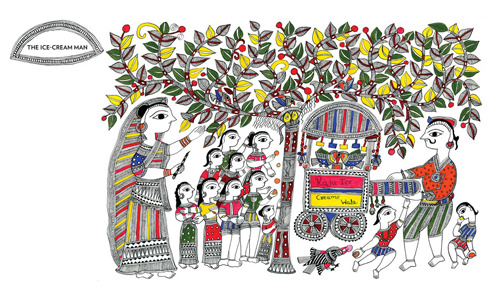
In addition to her everyday, rural scenes, Dulari is also well known as a painter of Ganesh images. Here is a Ganesh painting from 2010 now in a private collection.
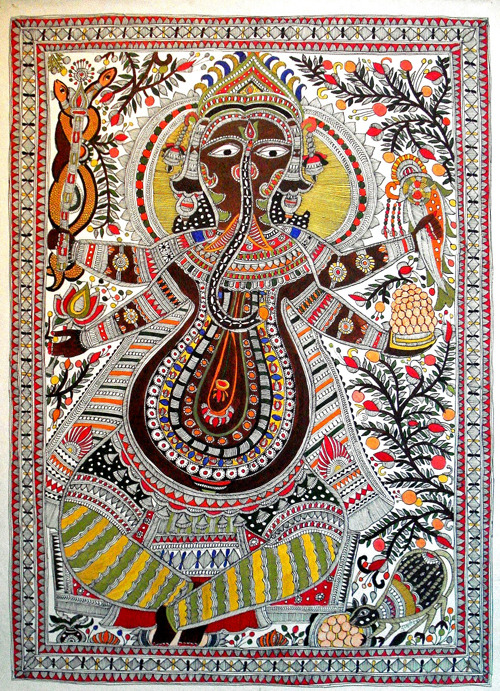
The Ganesh is quite a change from Dulari's quiet paintings of everyday village life with their realistic but prosaic colors. Here the intense, intricate patterns and color, on every inch of canvas, overloads our senses. At first only the eyes are clearly visible while all else is an almost psychadelic profusion of color and pattern. As we begin to separate shape from pattern, Ganesh's full form fills the entire canvas while decorative foliage occupies any remaining space. This is not a painting of what Dulari sees daily in her village of Ranti. No longer bound to record what is actually there, she gives free reign to her imagination and with exuberance depicts this most favorite of gods.
Here is a photo from 2010 in the home of Mahasundari Devi where Dulari Devi learned to paint.
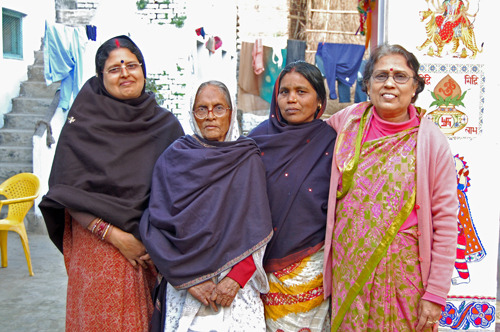
From the left: Bibha Das, Mahasundari Devi, Dulari Devi, Vibha Jha.
Both Bibha Das and Mahasundari Devi have received national recognition as artists. Dulari Devi is sure to receive that honor soon. Vibha Jah is with the Ethnic Arts Foundation.
Below is one of many decorative murals painted by Dulari in her employer's home. Note the same clean forms - and those ballooning semicircular saris.
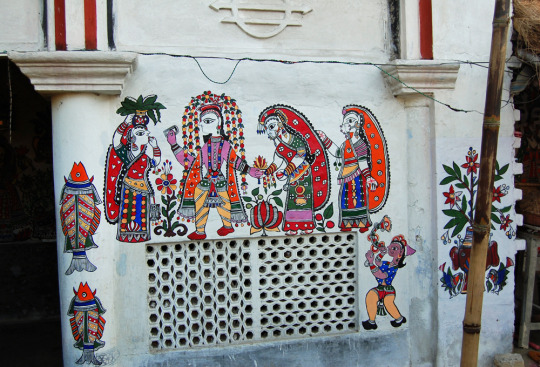
I first met Dulari Devi in January of 2010. She had recently finished the illustrations for Following My Paint Brush and was still working as a maid. Her art was gaining recognition and her hope was that soon she would be able to paint full time. I saw her again a year later. She said she was no longer working as a maid. She had become a full time artist.
Following My Paint Brush is available in the US. Amazon carries it at $13.65. A great stocking stuffer for yourself or as a gift.
2 notes
·
View notes